









As we celebrate the 10th anniversary of the Novolex brand, we are fortunate to reflect on the significant progress we have made through innovative solutions, strategic partnerships and a steadfast dedication to sustainable practices. At the heart of our success is the Novolex family. Our people are the driving force behind everything we do, and we remain committed to fostering an inclusive culture where everyone feels welcomed and valued. The next decade of Novolex will be defined by excellence in programs that support our Sustainability Pillars—Products, Operations and People and Communities. Our work in these areas is leading to a safer workplace, higher retention, enhanced productivity, greater employee engagement and advancing our sustainability goals.
In 2024, we remained on track to reduce greenhouse gas (GHG) emissions by 30% by 2030 by accelerating initiatives to reduce energy use in our manufacturing facilities. Additionally, we expanded our portfolio by investing in innovative brands such as OZZI®, a leader in reusable packaging, and American Twisting, manufacturers of twisted-paper handles for our Duro® paper bags. These investments contribute to our broad portfolio of diverse packaging solutions that support our customers’ sustainability goals.
In April 2025, we took a significant step forward in our sustainability journey by completing our combination with Pactiv Evergreen, a leading manufacturer of fresh food and beverage packaging.
This transaction represents the largest growth initiative pursued by Novolex. Our combination with Pactiv Evergreen delivers greater choices to customers with more than 250 brands and 39,000 combined SKUs. Together, we offer our customers strengthened product offerings, manufacturing expertise, R&D capabilities and more.
In 2024, Novolex made significant progress in growing, evolving and advancing our sustainability vision. However, our work is far from over Today, with more than 20,000 dedicated Novolex family members across North America and Europe, our vision continues to grow in purpose. Our unwavering commitment and dedication to making a difference for our planet and
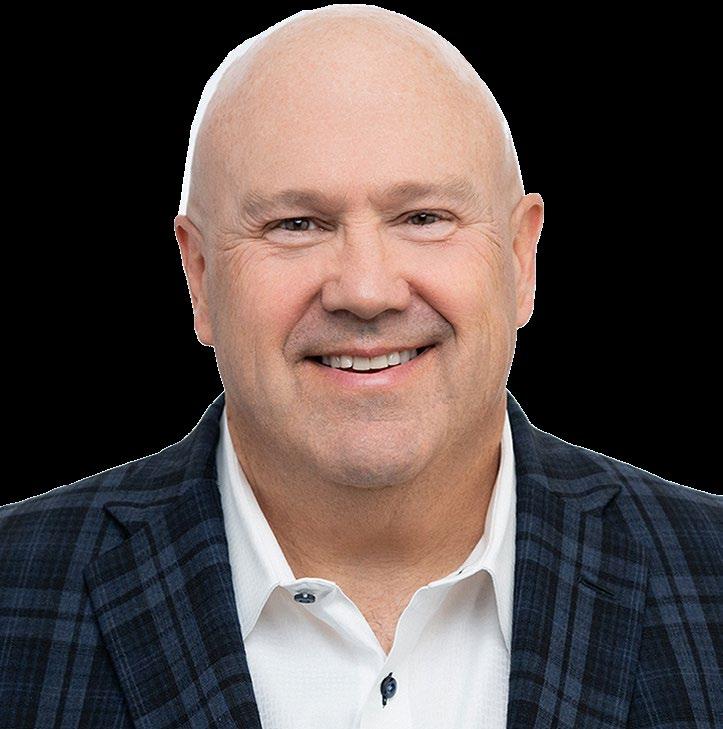
This is an exciting chapter in the Novolex growth story as we welcome Pactiv Evergreen to our company. Together, we are well positioned to grow as we leverage our combined talents and capabilities to better meet our customers’ evolving needs. I look forward to working with our new, expanded Novolex family to advance our sustainability initiatives and transform the future of packaging.

Stan Bikulege, Chairman and CEO



Our sustainability approach is rooted in strategic growth, innovation, and a commitment to offering diverse, responsible packaging solutions across industries. While Novolex continues to advance our product offerings to meet customer needs, we maintain transparent practices and align our business strategy with evolving sustainability goals.
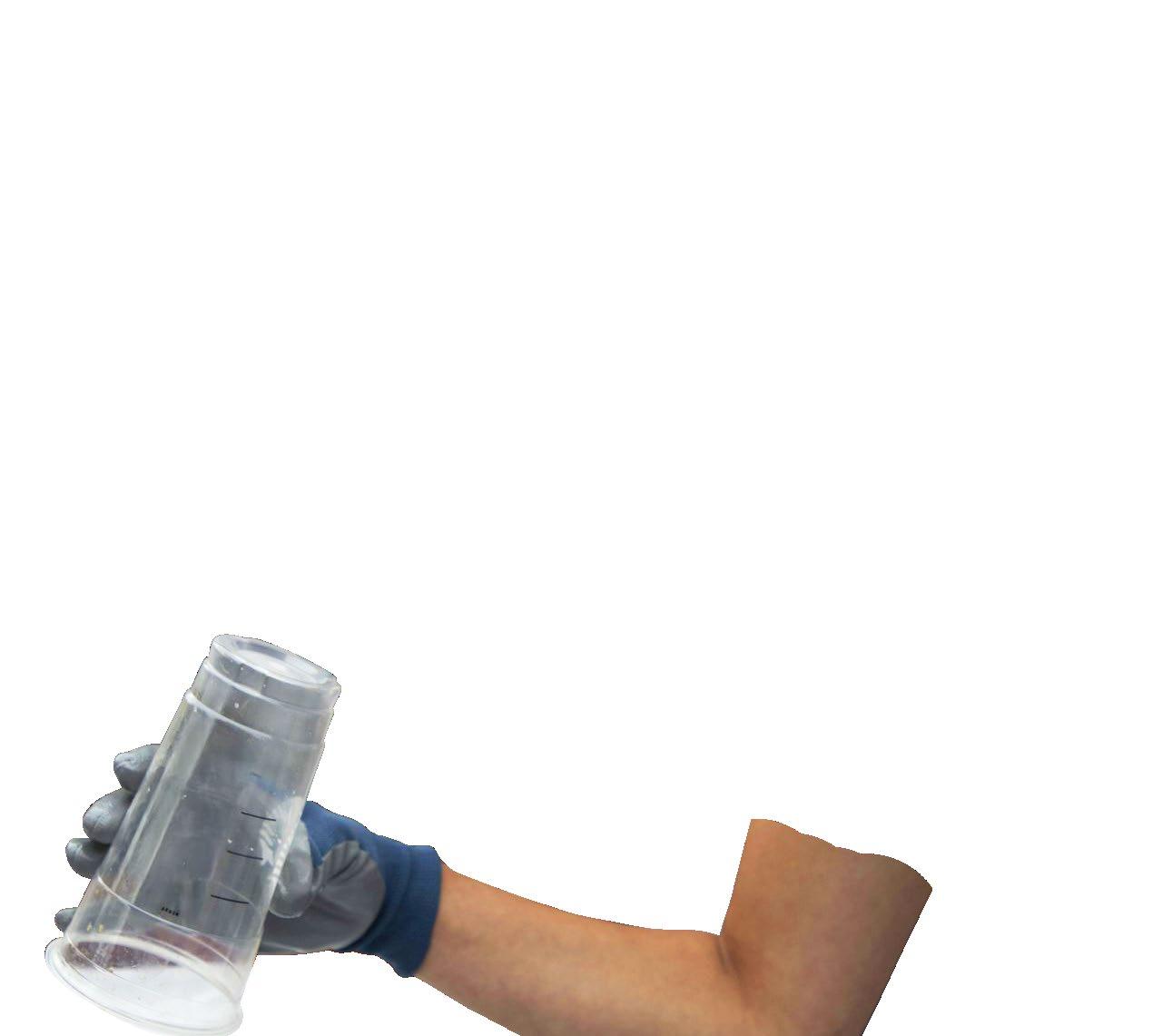
Novolex is a leading manufacturer of food, beverage and specialty packaging that supports multiple industries, including the foodservice, restaurant delivery and carryout, food processing, grocery and retail and industrial sectors. The Novolex story began in 2008 with Hilex® Poly, our business that continues to manufacture and recycle resin-based bags. Over the ensuing years, our progress has been fueled by a combination of organic sales growth which has, in turn, fueled our ability to acquire or invest in 14 businesses through the end of 2024. Each of these businesses has added to the choices of packaging solutions we can offer to a growing customer base. Today, our innovative product portfolio is designed to meet the diverse needs of businesses worldwide, and the millions of customers they serve.

Novolex grew with Hilex® Poly, our business that manufactures plastic retail bags.

Duro® Bag and Bagcraft® Packaging, well-respected paper packaging solutions, joined Novolex.

Burrows Packaging™, a manufacturer of paperbased food packaging and Heritage Bag™, a leading producer of can liners, brought further packaging expertise to Novolex.

Zenith Specialty Bag, a manufacturer of paper food packaging products, joined Novolex.

2008 2014 2016 2019 2021

Flexo Converters USA and Vegware joined in 2021, advancing our recycled and compostable packaging solutions.

Novolex acquired American Twisting, a trusted supplier of high quality twisted-paper handles used in the production of paper bags.




We acquired the North American operations of Clondalkin’s packaging business. Growth continued with the addition of Wisconsin Film & Bag, a polyethylene films and bags company.


Novolex acquired Shields® Packaging, a manufacturer of custom flexible packaging and The Waddington Group, a supplier of recyclable and compostable products.

2013 2015 2020 2018
B&H Bag Company strengthened our paper bags and packaging portfolios.




Novolex makes strategic investment in Rhode Island-based reusable systems and container brand OZZI® The decision to invest in OZZI reflected growing market interest in reusables and our capability to develop and market reusables.

Novolex announced definitive agreement to combine with Pactiv Evergreen.
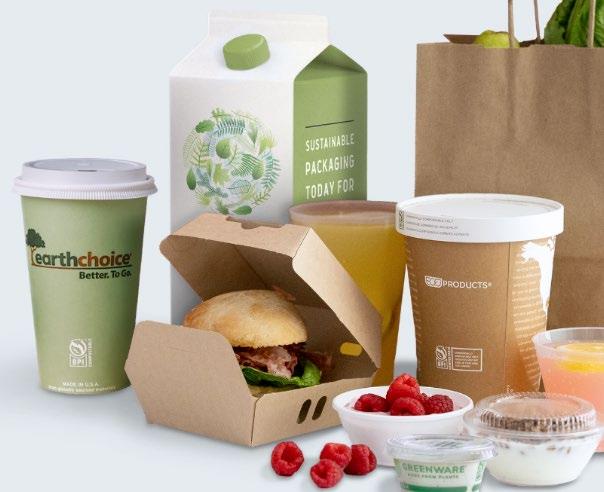

APRIL 1, 2025
Transaction closes, making the combination of Novolex and Pactiv Evergreen official.

Adding Pactiv Evergreen to our existing business under the Novolex brand aligns with our long-term strategy to maintain our position as a leader in the food, beverage and specialty products industry.
The combination also reinforces the Novolex commitment to customer choice, innovation and sustainability by bringing together two highly complementary businesses, creating a broad product platform and establishing one of the most diverse material offerings in the packaging industry. Our combined operations include an extensive footprint of more than 100 manufacturing facilities and regional mixing centers, enhancing our ability to serve customers ranging from large blue-chip brands to small businesses that together serve millions of consumers every day.

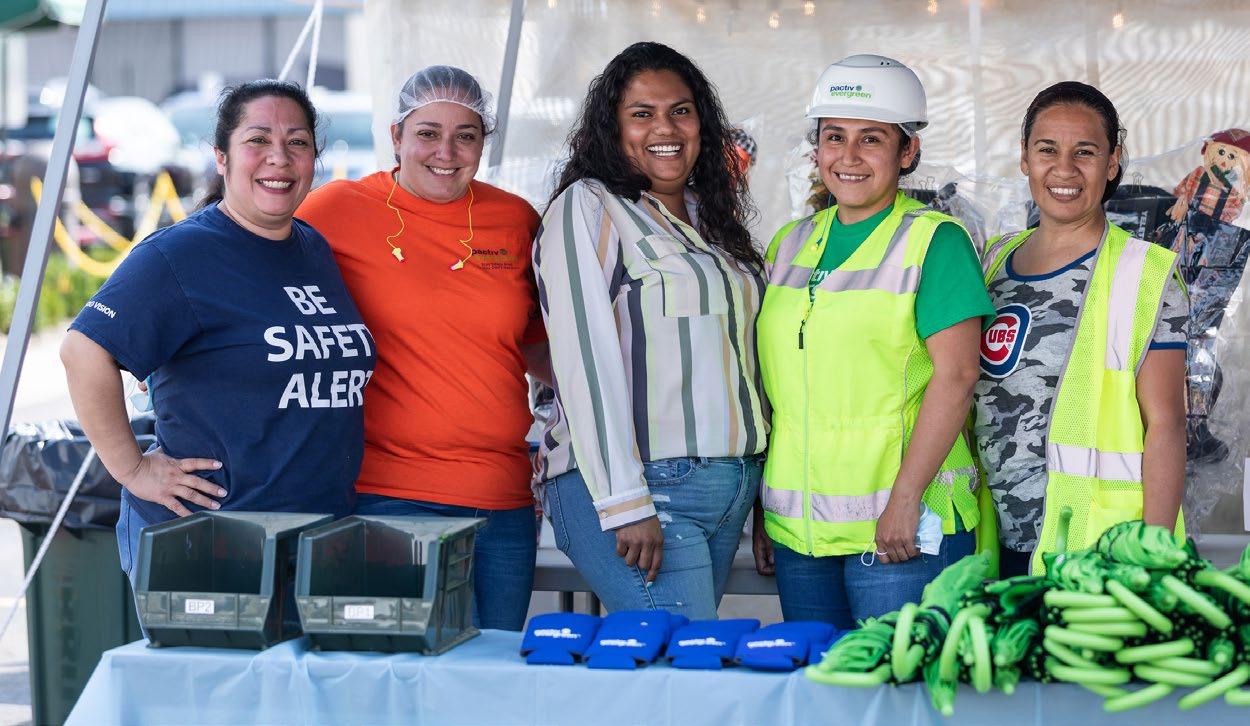


As regulatory and voluntary sustainability frameworks and reporting requirements continue to evolve, our approach to sustainability and reporting aims to evolve with them. This allows us to stay informed about emerging expectations for environmental, social and governance disclosures.
In 2023 and 2024, we began working towards the development of a Task Force on Climate-Related Financial Disclosures (TCFD) aligned Climate Risk Assessment covering facilities in North America and Europe to better understand the financial impacts of climate change on our business. In 2025, we expect to continue this analysis with a combined disclosure—representative of Novolex and Pactiv Evergreen’s combined operations—to support compliance with California’s Climate-Related Financial Risk Act (Senate Bill 261).
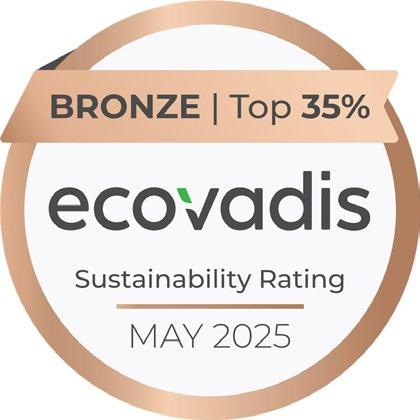
This report has been prepared in accordance with the Global Reporting Initiative and supports the Sustainability Accounting Standards Board’s Containers & Packaging industry standard.
Unless otherwise noted, the body of this report reflects primarily Novolex initiatives and performance from Fiscal Year (FY) 2024. In the Appendix, readers can find data disclosures for Pactiv Evergreen as the companies were separate entities in 2024. As mentioned above, we will publish a combined TCFD aligned Climate Risk and Opportunity Disclosure prior to January 1, 2026. For the 2025 FY, Novolex intends to publish a combined sustainability report covering the new company scope.
Customers and other stakeholders continue to use external rating platforms to assess corporate sustainability performance and manage supply chain risk. For Novolex responses submitted in Spring 2025, we improved our EcoVadis score from 61 to 66/100, placing Novolex in the top 80th percentile of responding companies and earning a Bronze Medal for the second year in a row.
We recognize that the language of sustainability is continually evolving. In this report we use the term “sustainability” to encompass a wide range of initiatives including policies, programs, procedures, products and more that align with customer and stakeholder expectations.
Our priority material issues in this year’s report remain consistent with the findings from our 2020 materiality assessment. Through ongoing conversations with internal and external stakeholders, Novolex constantly identifies and analyzes emerging trends, issues and opportunities for additional disclosures and programs. Refer to the Appendix for further details on our materiality assessment. If you have any questions or comments about this report, please contact sustainability@Novolex.com
Novolex continues to pursue our sustainability vision to innovate more sustainable choices for our customers, operate responsibly and invest in our people and communities.
By engaging with stakeholders, including customers, suppliers, communities and other industry partners, we consistently identify new metrics to measure our performance, refine our data collection methods and establish targeted initiatives to drive progress across our business. Since the publication of our first sustainability report covering FY 2018, we have expanded our use of key performance indicators (KPIs) to track progress. All reported metrics align with the Sustainability Pillars outlined below.
Novolex completed an initial Scope 1 and 2 GHG inventory in 2019 and continues to use FY 2019 emissions data as the baseline for our 30% by 2030 GHG reduction target. Until recently, few frameworks have required Scope 3 reporting. However, in response to growing stakeholder and regulatory expectations, Novolex has been taking steps to develop a comprehensive carbon data set that includes Scope 3 emissions. In this year’s report, for the first time we can provide quantified Scope 3 emissions.
Products: Take on a leadership role within the packaging industry by providing customers and their consumers with sustainable product solutions.
Operations: Strive for low-impact manufacturing and integration of sustainability into operations excellence.
Metrics, KPIs & Targets
Establishing a complete carbon inventory better positions Novolex to respond to customer requests, identify suppliers whose primary data will be important for evaluating progress, incorporate the results of our climate risk assessment and prepare for emerging regulations and reporting standards.
For our 2024 Scope 3 data, please see page 25. In our 2025 sustainability report, we intend to publish a carbon data set that is representative of the combined company and aligned with the GHG Protocol.
People and Communities: Support our employees, their families and communities and the consumers who use our products.
Percentage of raw materials from renewable, post-consumer recycled (PCR) or bio-based sources
Percentage of PCR in procured resin and fiber
Percentage of certified fiber
Percentage of revenue from products that are recyclable, compostable or reusable
Double PCR recycling in our North Vernon, Ind. recycling facility by the end of 2024
Reduce GHG emissions from energy use in manufacturing by 30% per ton of production by 2030
Significant air emissions
Waste management and footprint
Safety: Total Recordable Incident Rate
Percentage of females and minorities in leadership positions
Employee demographics
Internal promotions

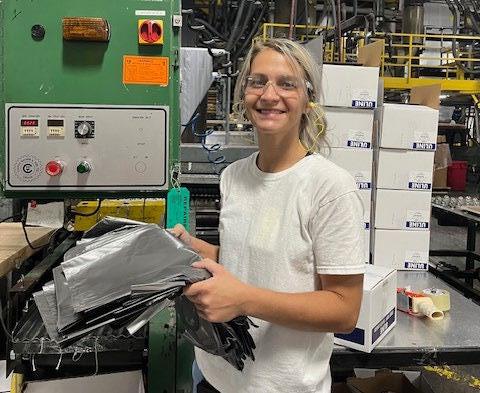

The Novolex Board of Directors serves as the highest governing body of the organization, providing oversight of the company’s policies and programs related to sustainability. Board members bring extensive experience from the global packaging industry, finance, supply chain management and sustainability-related disciplines, ensuring that our company’s initiatives keep pace with industry best practices and meet the expectations of our stakeholders. The Board and its committees meet four times annually to assess Novolex strategies that align with our Sustainability Pillars. During these meetings, the Board evaluates ongoing initiatives, receives updates on progress and offers strategic recommendations to guide future improvements.


As of July 2025, The Novolex Senior Leadership Team (SLT) consists of 13 members including the Novolex Chairman and CEO, four business unit presidents and eight functional executives, including our Chief Innovation and Sustainability Officer. The Board operates with three standing committees: the Audit Committee, the Compensation Committee and the Sustainability & Environment, Health and Safety (S&EHS) Committee, each focused on key areas of corporate governance and performance.
The S&EHS Committee is responsible for overseeing the company’s strategy and performance in all areas discussed in this report, including monitoring Novolex progress against key KPIs that align with our three Novolex Sustainability Pillars. Composed of four Board members, the S&EHS Committee provides guidance on emerging expectations that may impact the company’s sustainability goals, strategies and performance. The committee meets quarterly to receive updates from
the Novolex Senior Leadership Team (SLT), including the Chairman and CEO, as well as other subject matter experts within the company. In 2024, the committee reviewed a variety of topics including our role in the circular economy, the company’s product sustainability strategy, progress toward achieving GHG emissions reduction targets, climate change impacts, social compliance initiatives and employee health and safety programs. Additional details on these topics can be found in the Products, Operations, and People and Communities sections of this report.
With the close of the transaction combining Novolex with Pactiv Evergreen on April 1, 2025, funds managed by Apollo affiliates hold a majority ownership stake in Novolex.
As of July 2025, minority stakes in Novolex are held by CPP Investments and by some members of company management. Apollo and CPP Investments each share a deep commitment to supporting value-added decarbonization and climate-related initiatives across their funds’ portfolio companies.
At Novolex, ethical behavior and integrity are at the core of our values and essential to our reputation in the marketplace. Our policies provide clear guidance to employees, management and the Board of Directors on how to uphold these principles in practice and ensure compliance across all aspects of our business. The Novolex Anti-Abuse & Fair Treatment Policy fosters an inclusive workplace, upholding the right of employees to be treated with fairness and equity in an environment free from discrimination, harassment and retaliation. The Novolex Anti-Bribery & Anti-Corruption Policy outlines employee responsibilities in accordance with relevant anti-bribery laws and company policies, offering tools and support to help identify and address related risks. Similarly, our Anti-Trust & Competition Policy specifies employee responsibilities under applicable anti-trust and competition laws, providing the necessary resources to recognize and mitigate risks. Additional policies related to compliance are discussed in the People and Communities section of this report.
The Novolex cybersecurity framework is based on the U.S. National Institute of Standards and Technology Cybersecurity Framework, a comprehensive set of guidelines and best practices widely endorsed by industry experts and regulatory bodies. Our cybersecurity efforts are guided by multiple company policies that ensure the protection of data and systems across the organization. The Novolex VP of Global Technology and Cybersecurity leads a robust multi-
faceted approach to risk management, which includes proactive threat detection, incident response planning and continuous improvement of security protocols. The Audit Committee of the Board of Directors receives regular updates on cybersecurity progress and provides strategic guidance to further strengthen our cybersecurity posture. By adhering to the National Institute of Standards and Technology Cybersecurity Framework, Novolex strengthens our defenses against emerging cyber threats and demonstrates our commitment to maintaining a security framework that exceeds industry standards and regulatory requirements. This proactive approach not only safeguards our assets and data but also maintains the trust and confidence of our customers, partners and stakeholders, positioning Novolex as a leader in cybersecurity excellence within the industry.
Novolex applies sustainability principles to our product portfolio and operations and develops programs to build awareness of our principles among our employees and in our communities. The Novolex Sustainability Policy, which has been endorsed by the S&EHS Committee of the Board of Directors, establishes our commitment to address expectations of our employees, customers and suppliers as well as those of the diverse communities with whom we interact. Each year, our sustainability report documents and communicates our progress toward fulfilling commitments outlined in the policy.
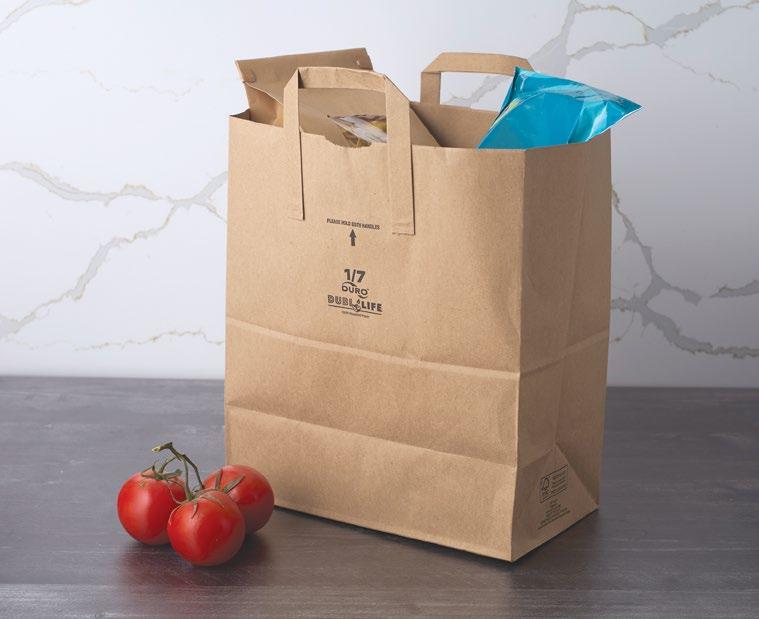

At Novolex, we take a comprehensive approach to the entire lifecycle of our products. We partner with our customers and other stakeholders to identify raw materials and product designs that balance societal needs, GHG emissions and product disposal options. This results in a new product development process that is continuously expanding our portfolio to offer innovative, circular solutions that align with evolving environmental standards and customer expectations.

We conduct product carbon footprint (PCF) analyses and lifecycle assessments (LCAs) to quantify the environmental impacts of our products at various stages in the value chain. Novolex continues to make strides in delivering product-level carbon data to customers. This data plays a critical role in guiding raw material selection and product design decisions in the major end markets we serve. By deepening our understanding of emissions generated at each stage of the supply chain, we position Novolex to engage in meaningful, strategic discussions with customers about how our products align with and support their carbon reduction and circular economy goals.
Novolex uses the Trayak EcoImpact COMPASS sustainability platform, an ISO 27001 certified tool designed to prepare LCAs to quantify the benefits or impacts of different raw materials and product design decisions. Using industry-leading lifecycle inventories, Trayak EcoImpact COMPASS provides assessments of the carbon-related impacts of packaging and other products. Trayak EcoImpact COMPASS also conforms to ISO 14040 and 14044, representing a robust approach to product LCA.
In 2024, we made progress incorporating primary data from suppliers into our PCF analyses. This work complemented analyses performed using secondary data from lifecycle inventories. Novolex intends to continue this work with further outreach to key suppliers, focusing on continuously building primary raw material data into our PCF analyses and carbon inventory.
We fulfill the Novolex brand promise to provide customers with choice, innovation and sustainability starting with our selection of raw materials. Over the years, Novolex has supported evolving customer needs by expanding the diversity of materials we use in our product lines, ensuring we meet both functional and sustainability requirements. This commitment enables us to provide innovative solutions that align with the growing demand for environmentally responsible products.
of Novolex raw materials came from renewable, bio-based or PCR sources in 2024
Novolex raw materials from renewable, bio-based or PCR sources remained consistent with 2023. Our raw materials include multiple bio-based resins, postconsumer recycled (PCR) paper and resins, virgin resins and paper, aluminum, sugarcane (bagasse), wood, bamboo and more.
Derived from plants like corn and sugarcane, bio-based resins and bioplastics such as polylactic acid (PLA) and polyhydroxyalkanoate (PHA) provide the packaging industry and our customers with a renewable and often compostable packaging alternative.
These materials feature many of the same performance benefits as conventional resins derived from fossil fuels.
Novolex is at the forefront of using bio-based resins and renewable materials in a growing number of products including hinged containers, cups, straws, can liners and produce bags. We continue to test the limits of these resins as the market demand for renewable, compostable and bio-based alternatives grows.
A rising number of Novolex products are made from molded fiber, a renewable raw material derived from resources like bamboo, wheat straw, miscanthus and bagasse, a by-product of sugarcane pulp. These raw materials are not only renewable, but by using sugarcane pulp, which is a by-product of sugar production, we also help reduce waste and promote a more circular economy.
Informed by the priorities outlined at the 2024 United Nations Conference of the Parties Climate Summit (COP29), including accelerating the transition to renewable energy, strengthening deforestation commitments, committing to net reductions in fossil fuel use, and enhancing financing for reforestation and sustainable land use in vulnerable regions, Novolex is sharpening its sustainability strategy to meet the evolving expectations of our industry and stakeholders.
Reflecting the priorities set at COP29, sustainability is a pillar of how we innovate, manufacture and bring products to market. As we evolve our business in combination with Pactiv Evergreen, we elevated the Sustainability function to report directly to the CEO and create a new executive position on our leadership team: Chief Innovation and Sustainability Officer. This leadership realignment underscores our commitment to integrating sustainability across our operations.
With Sustainability now fully integrated with innovation and product development efforts, Novolex is better positioned to design, market, and deliver more sustainable products. This shift will continue to advance our efforts in measuring and evaluating raw material and product options, with a strong focus on integrating carbon data into our decision-making process. These efforts will enable us to deliver more informed, responsible product recommendations to our customers and support the broader global transition toward a resource-conscious future.


In 2024, 5% of total purchased resin by volume came from PCR content, representing a 1% increase over 2023 and a 2% increase over 2022. Bio-based resins in the Novolex portfolio remained at 2% of our total resin sourcing volume.
In our businesses that use paper, PCR utilization remained at 52% of our overall fiber volume.
Novolex is committed to optimizing the use of ethically sourced paper from well-managed forests. More than 99% of the paper we purchase comes from suppliers certified by internationally recognized forestry certification programs, including the Forest Stewardship Council®, the Sustainable Forestry Initiative®1, or the Programme for the Endorsement of Forest Certification. 1 Sustainable Forestry Initiative marks are registered marks owned by the Sustainable Forestry Initiative Inc.




In September 2024, Novolex introduced our Sustainable Forestry Policy, which sets out our principles for sourcing forest-based materials for paper packaging. While these priorities are not new, the establishment of this policy marks a step forward in communicating our expectations to stakeholders. It also applies to our suppliers, adding to efforts that support compliance with the European Union Regulation on Deforestation-Free Products. This policy promotes sustainable harvesting, replanting, water conservation, biodiversity and fair labor practices in line with industry standards and regulations.
In 2024, 13% of our virgin fiber volume was certified chain-of-custody (COC), representing a 1% decline compared to 2023. The slight shift in COC fiber volume is due to changes in demand with key customers that purchase COC fiber for their products.
COC fiber is traceable to forests that meet rigorous sustainability criteria, including requirements for replanting after harvesting and ensuring fair labor practices to protect workers’ rights. Because COC certified fiber represents a higher standard for sustainably sourced virgin fiber, we distinguish it in our reporting. We do not report volumes of COC certified recycled fiber because the custody chain is more important when dealing with virgin harvested fiber.



We have continued our efforts to increase polyethylene film recycling. In 2023, we set a target to double the volume of PCR films recycled in our North Vernon, Indiana recycling facility by the end of 2024. This goal was part of an effort to grow volumes of recycled content following significant capital investments in our North Vernon recycling facility. We achieved 89% of our target in 2024. While we fell slightly short of our goal, these and other efforts contributed to overall growth in our reported PCR metric.
In addition to investing in our own recycling facilities, Novolex also supports growth in film circularity by collaborating with NOVA Chemicals® Circular Solutions to operate a plastic film mechanical recycling facility in Connersville, Indiana. In 2024, the U.S. Food and Drug Administration issued a Letter of Non-Objection to produce PCR linear low-density polyethylene material suitable for broad food-contact applications. Beyond circularity, NOVA’s investment is making a tangible difference for the Connersville community. With nearly 125 employees, the facility is breathing new life into a former automotive plant and contributing to regional growth.

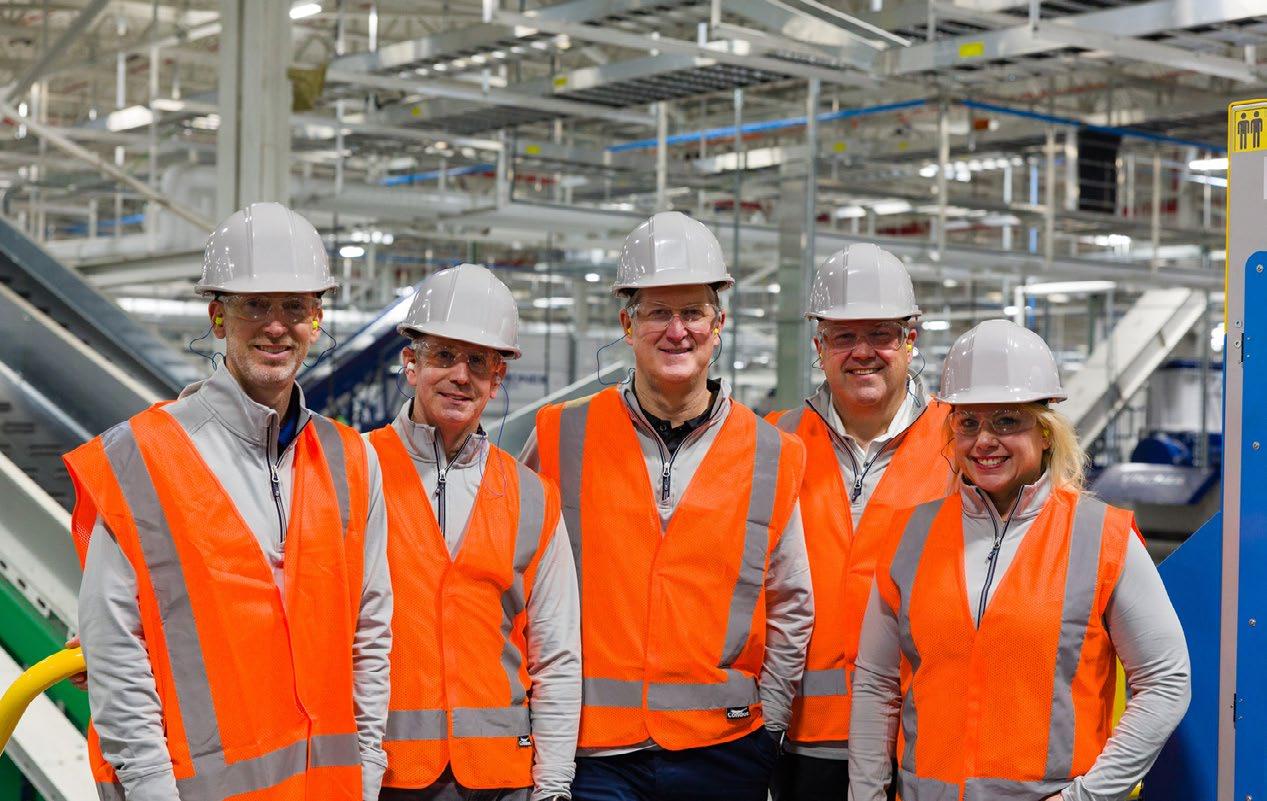
“To have a facility like this with 125 families making a difference—it’s tremendous. We should all be proud of what this represents. It’s a privilege to be able to collaborate with our long-standing supplier, NOVA Chemicals, to make this happen and build on our shared commitments to safety, sustainability and community.”
The NOVA Chemicals logo is a registered trademark of NOVA Brands Ltd.
In 2024, Novolex saw continued growth in revenue from applicable1 products that are recyclable, compostable or reusable, reaching 86%, an increase of 2% compared to 2023. The increase reflects ongoing efforts across our portfolio to innovate and enhance products designed for recycling, composting and reuse.
To measure revenues from our North American products that can be recycled, we utilize How2Recycle® definitions managed by the Sustainable Packaging Coalition. Those classifications include “Widely Recyclable,” “Check
1 A share of Novolex products are excluded from the scope of the SASB metric because they do not appropriately classify as recyclable or compostable. Examples of these products include trash can liners and materials used to manufacture products used in construction and other durable applications. These products make up approximately 18% of Novolex revenues.
Locally,” “Store Drop-Off” and “Not Yet Recyclable,” which are guided by the U.S. Federal Trade Commission and Canadian Competition Bureau. For our European products, local regulatory agencies provide definitions based on the availability of collection and processing infrastructure. Compostable products included in our metric possess third-party certifications, such as the Biodegradable Products Institute (BPI), or have been tested to verify performance consistent with accredited industry standards. In cases where products of greater mass have been certified or tested, the same product of smaller mass may also be counted in our metric. Reusable products are classified based on regulation or have been tested to verify performance consistent with accredited industry standards. As we move forward with reporting this metric, we will continue to monitor regulatory guidance emerging from around the world to guide our classifications.

Western Michigan University (WMU) has a pilot-scale recycling facility that can recycle, repulp, and de-ink a wide variety of post-consumer waste. The university has earned a reputation in the paper and fiber packaging industry as a resource for companies that want to validate the recyclability of their fiber-based products. Using industry protocols, WMU assesses products based on whether packaging items can be separated for recycling without causing contamination to recycling streams and whether the packaging item can be repulped into new raw material. WMU offers a “Recyclability Certification” based on successful testing that occurs at WMU’s Pilot Plant, which is not affiliated with any company or commercial entity, so recyclability is determined in an independent environment. This Window Bread Bag received WMU’s Recyclability Certification in 2024, which led to it receiving the “Widely Recyclable” designation from How2Recycle.


Starting in 2021, Novolex began partnering with WMU to assess several fiber-based products which have direct food contact but are unlikely to leave a food residue on the packaging. WMU testing confirmed that despite the presence of the film window, these bread bags are capable of being recycled at curbside without the need for additional steps by the consumer.
Liz Jones, Senior Product Manager, Bagcraft Division of Novolex
Recognizing that food waste is a major contributor to global methane emissions, Novolex remains committed to advancing food packaging solutions that support food waste diversion from landfills. The range of certified compostable products available in our portfolio has grown significantly in response to increasing demand from our customers and their consumers. Our innovation teams partner with customers, suppliers and industry associations to design products that are certified for commercial composting, and work to ensure product labeling provides accurate instructions for disposal. Most Novolex brand compostable products are commercially compostable only. Composting facilities may not exist in all areas. Products acceptable for home composting are labeled accordingly.
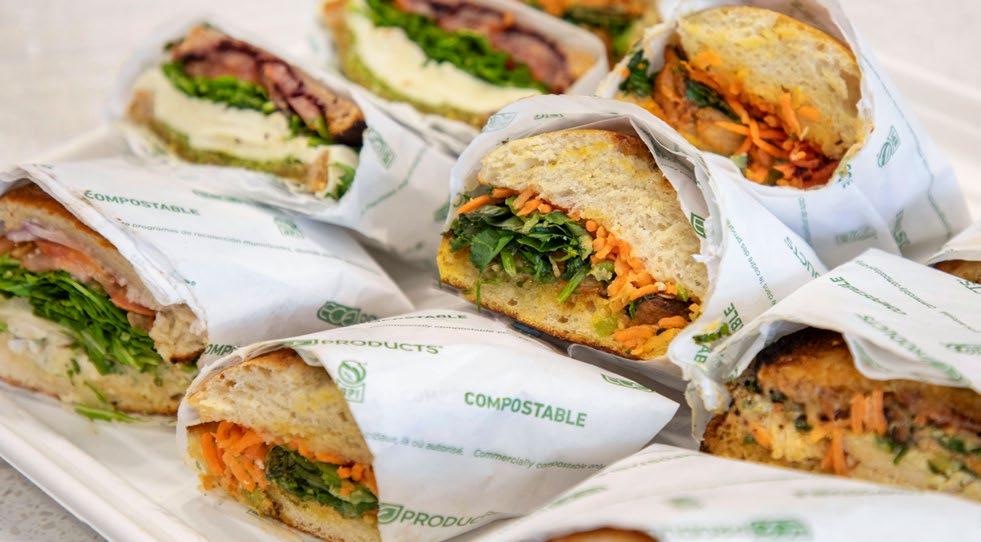

Eco-Products® has expanded its Green Stripe® line of compostable packaging with a variety of new paper bags, sandwich wraps and other items, all certified by BPI. These products, made without intentionally added per- and polyfluoroalkyl substances (PFAS), are ideal for supermarkets, restaurants, bakeries and foodservice operators, providing renewable, certified compostable solutions for take-out programs. Additionally, the paper carryout bags are Forest Stewardship Council certified to come from responsibly managed sources.


In 2024, Eco-Products expanded its Veridian™ line of cups, lids, containers and cutlery, designed to comply with the state-wide compostable product labeling requirements enacted in 2024 in Colorado and Washington State. All Veridian products are clearly marked with the word “Compostable” and feature distinctive green or brown tinting and striping, making it easier for consumers, composters and the foodservice industry to differentiate between compostable packaging and non compostable options. Certified compostable by the BPI, Veridian products comply with emerging labeling regulations across the U.S.
TerreGloss™ and Terrecote™ butter wraps, which are BPI certified for compostability in commercial facilities, received the 2025 Gold Award for Sustainability from the Flexible Packaging Association. This innovative packaging is designed to meet the growing demand from both consumers and dairies for compostable packaging. Made from a renewable paper base and alternative inks, these wraps use a PFAS-free, highperformance wax blend to protect the butter while offering easy-to-open convenience and custom design options.




In 2024, Novolex introduced Power Prep™ wraps and rolls which are designed to maintain the flavor and quality of grab-and-go sandwiches and premium togo foods through a full cycle of wrapping, freezing, reheating and holding under heat, reducing packaging by eliminating the need for multiple packages during the lifespan of the food item. These multilayered wraps control moisture and heat, maintaining fresh taste and top quality. Made with oil- and grease-resistant paper without the use of intentionally added PFAS, Power Prep wraps and rolls offer superior puncture resistance and custom branding options, making them an ideal solution for convenience stores, supermarkets and foodservice operators.
All Eco-Products Green Stripe cold cups manufactured in our Chattanooga, Tennessee facility are now packaged in product sleeves made with blue-tinted 25% PCR film content. This change reduces reliance on virgin plastic and is a positive step toward increasing the use of PCR in both our products and the secondary packaging in which our products are packaged. These sleeves are also recyclable through store drop-off programs.
1 Data sourced from Ecoinvent lifecycle inventory. Total product weight was unchanged.
Many Novolex customers from the banking sector rely on our Shields® division to manufacture polyethylene film “deposit bags” which are used by banks and other institutions for valuables storage and recordkeeping. In 2023, our sourcing and sustainability teams engaged with a customer to identify ways to reduce the use of virgin resin in their products. Working closely with Shields’ sales and product teams, Novolex conducted PCF analyses for three different kinds of deposit bags used by the customer. The findings validated that using 50% PCR resin has the potential to reduce the carbon footprint of the raw materials in the product by 26%.1 Fortunately, this material can be sourced internally from the Novolex Recycling Center in Shawano, Wisconsin, which specializes in recycling polyethylene “stretch wrap.” Using PCR resin made in Novolex facilities, Novolex innovation teams went to work to design new deposit bags that meet all functional requirements, while also using a lower carbon footprint raw material. The resulting new products support customer sustainability goals by reducing the carbon footprint of the product.
Novolex TamperFlag™ rigid containers feature a tamperevident flag that pops up and stays raised once opened, ensuring food security and consumer peace of mind. These containers can be made with up to 50% PCR plastic content depending on customer specifications. The containers also eliminate the need for tear strips and shrink bands, ensuring that the package is a single material and meets size requirements in markets where rigid polyethylene terephthalate (PET) plastic (thermoformed) containers are accepted for recycling.
In 2024, Novolex made a significant strategic investment in OZZI, a Rhode Island-based brand specializing in reusable systems and containers. The OZZI family of products includes innovative containers, cups and cutlery equipped with barcodes that track O2GO® items. These items are compatible with the OZZI Drop N’Go Collection Systems, facilitating collection, washing, sanitizing, drying and storage of returned reusables. OZZI products are purposefully designed for closed-system environments, including colleges and universities, corporate campuses, military bases and hospitals. Once OZZI containers can no longer be reused, they are recycled, supporting a more sustainable lifecycle. The partnership has expanded globally, as U.K.-based Vegware™, a sister company of Eco-Products, and Eco-Products divisions in Canada and Europe, gained access to the full array of OZZI products and solutions, accelerating the adoption and demand for these products in new markets.
Eco-Products launched Veda™ containers, designed for reuse systems with easy return and washing in closed-system environments like college campuses and hospitals. Featuring OZZI tracking technology, customers can return used containers for credits or deposits. This initiative supports Novolex sustainability efforts by complementing compostable solutions and reducing waste.
Eco-Products continued its successful reusable drinkware program at the Moda Center in Portland, Oregon, marking the continuation of the first full-venue reusable packaging program in professional sports.
Fans can return Rip City Reuse branded cups on premises for cleaning and reuse throughout the arena. Our commitment to reusable products has fostered partnerships with leading organizations that are guiding the way in reuse systems, further advancing our efforts to drive sustainability in the foodservice industry.
Frost-Flex cups are designed as a promotional item, and can be custom branded for country clubs, casinos, stadiums, restaurants and any special event requiring sophisticated drinkware at an affordable price. Their flexible polypropylene material is unbreakable and durable, giving the cups properties that enable multiple uses.



At Novolex, we continue to advocate for responsible legislation, regulation and standards that foster stability, transparency and accountability within the packaging sector while supporting the communities we serve. In 2024, we witnessed both ongoing and new policy discussions centered on key sustainability topics, including recyclable and compostable labeling and claims requirements, PCR content requirements, extended producer responsibility legislation for packaging and other waste and resource themed policies.
As a leader in sustainable packaging, Novolex is well positioned to capture and understand the diverse perspectives of consumers, operators, distributors, composters, recyclers, raw material suppliers and other stakeholders throughout the value chain. This broad insight has established us as a trusted thought leader and resource for policymakers, regulatory agencies, community leaders and others working to create improved end-of-life solutions for packaging.
Our engagement efforts focus on fostering the development of well-crafted policies that enhance the recyclability and compostability of packaging while improving access to, and the effectiveness of, recycling and composting infrastructure. To drive these efforts forward, Novolex invests in key trade association partnerships that support research, scalable pilot programs, grants for recycling centers and conducts consumer outreach aimed at boosting recycling and composting. In 2024, our policy involvements centered around driving circularity for Novolex products.
We took a proactive approach to strengthening communication with our customers, providing valuable guidance to help them comply with applicable laws and standards. We also participated in regulatory agency workshops and working groups where our technical experts provided critical guidance and counsel.
As new policies emerge, Novolex collaborates closely with our customers, suppliers and other stakeholders to develop compliant products that align with these evolving regulations. Notable examples include our product lines that adhere to compostable labeling standards in Washington State and Colorado, as well as can liner (trash bag) offerings that support PCR content requirements in New Jersey and Washington State.
In 2024, we partnered with the Flexible Film Recycling Alliance to announce the launch of the new Plastic Film Recycling Directory, a pivotal resource for store takeback recycling of bags and film. This initiative is spearheaded by the Flexible Film Recycling Alliance, a self-funded group of the Plastics Industry Association, and marks a major milestone in advancing educational resources that support collection of recyclable polyethylene (PE) films. We will continue to advocate for this project, contributing both financial support and expertise alongside industry partners. We will continue to advocate for this project, contributing both financial support and expertise alongside industry partners.
Search your zip code to find a location here










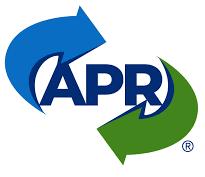








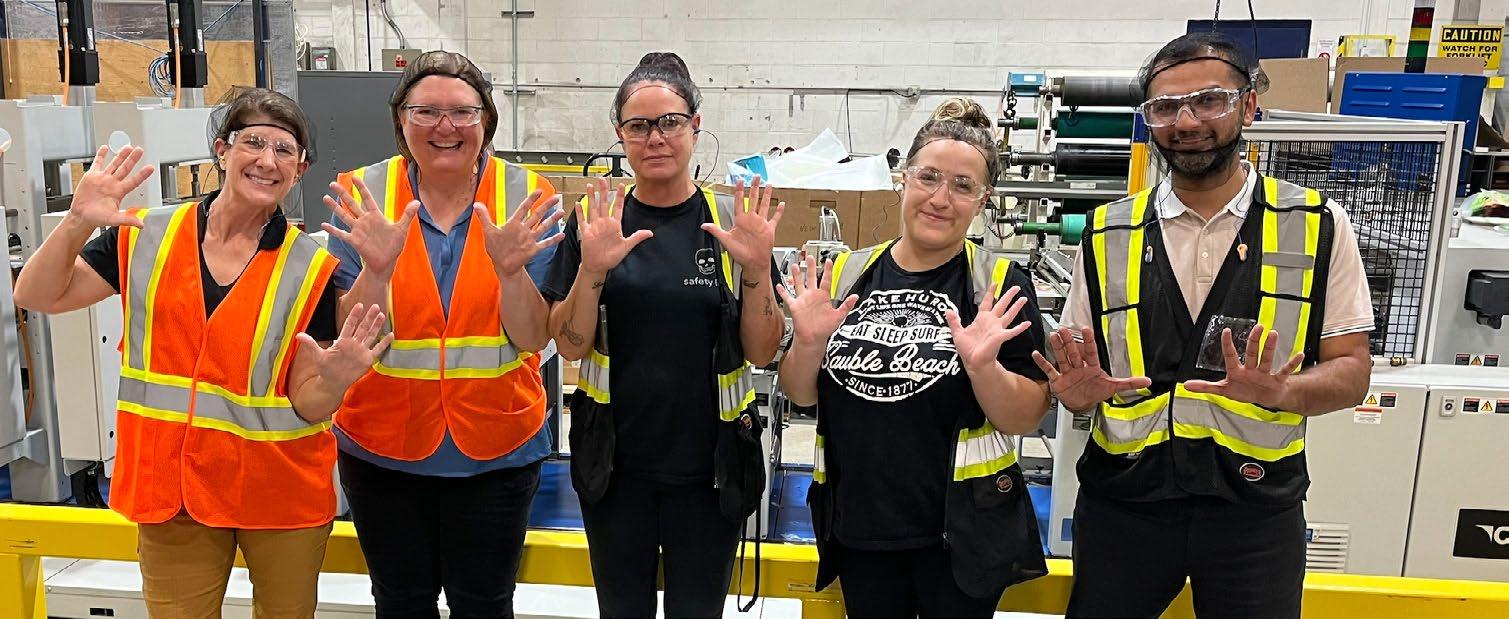
At Novolex, environmental stewardship is a core value shared across our organization. As we recognize our responsibility to reduce environmental impacts across our manufacturing operations, we have created a growing number of operational KPIs that focus on key areas of our environmental footprint. By cultivating a culture that prioritizes measurement, we strive to continue progressing in areas such as emissions reduction, energy efficiencies, waste reduction and more, remaining accountable and continuing to advance our sustainability goals.
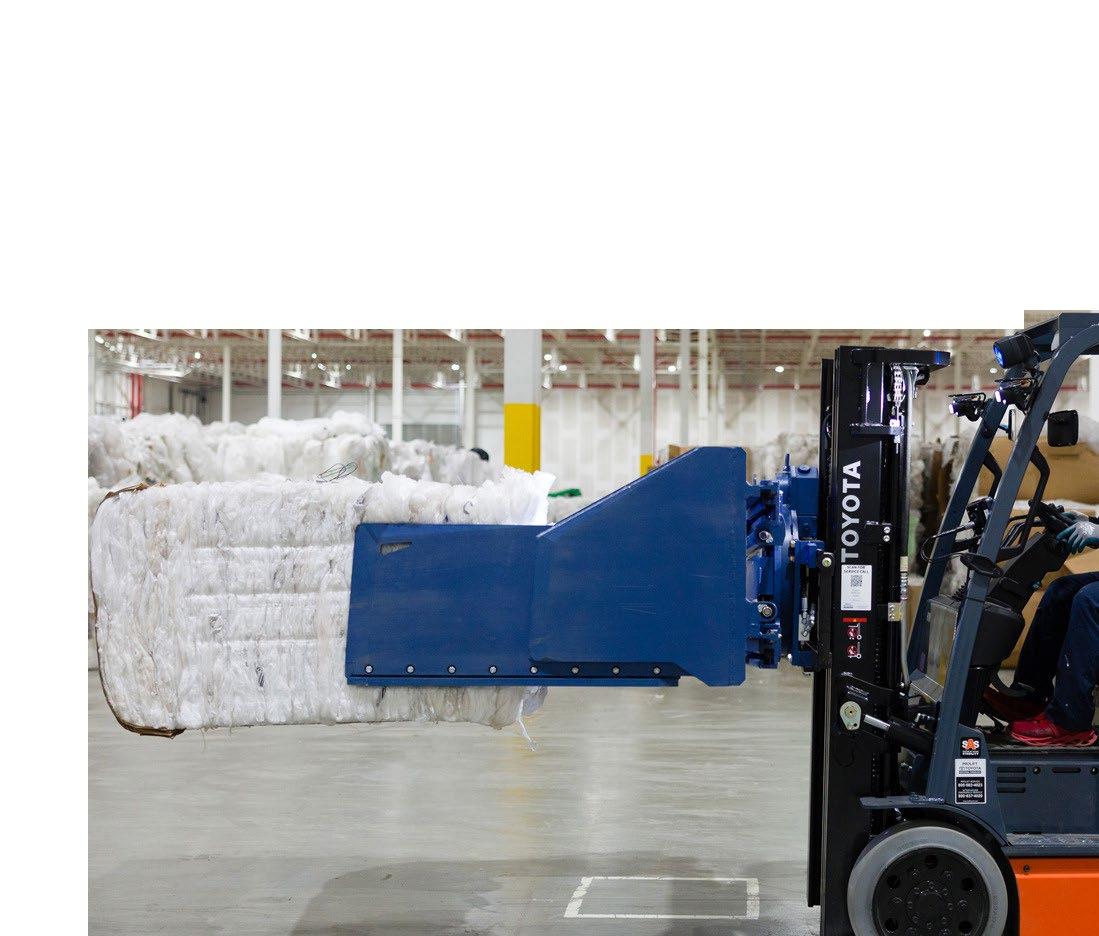

Recognizing our role in mitigating climate-related impacts, such as the escalation of global temperatures, sea level rise and extreme weather events, we established a company-wide baseline for our global emissions in 2019. This baseline enables us to establish a clear target, track measurable progress and identify improvement opportunities across our operations.
In 2024, Novolex progressed its commitment to reduce GHG emissions from our manufacturing activities. Driven by strategic investments and operational improvements, we continue to advance our efforts to use energy more efficiently. Since 2019, Novolex has reduced its global emissions by 25%—well on our way to meeting our 2030 target.

25%
Progress achieved since 2019.
30%
Novolex Target: 30% reduction in global emissions per ton of production by 2030.
To meet our ambitious goal, we reviewed opportunities at the intersection of sustainability, cost savings and productivity, focusing on plants located in geographies where the emissions per kilowatt hour were the highest. Additionally, working with our energy partners we conducted audits across 16 facilities and identified over 100 energy efficiency opportunities. These initiatives targeted a broad range of projects, including lighting upgrades, metering, mechanical systems optimization, solar installations and process equipment improvements.
Novolex also purchases renewable energy credits and power purchase agreements to reduce our emissions and support the future of renewable energy. The combination of these efforts keeps us on track to reduce our carbon footprint in line with our target. In 2024, we purchased over 83,000 megawatt hours of renewable electricity, representing 9% of our total energy usage.
Novolex received Apollo’s Sustainability Performance Award presented at their bi-annual Responsible & Sustainable Portfolio Conference. Novolex was one of four companies awarded among more than 60 companies attending the conference. The award recognized the role of our sustainability-linked financing (SLF) agreement to help drive a multiyear program to reduce GHG emissions resulting from energy use in our facilities.
Since our target is part of an Sustainability-Linked Financing (SLF) agreement, progress towards our emissions reduction target is audited annually by a third party. Upon achieving annual KPIs, Novolex receives a discount on our debt financing. This helps to link environmental and financial outcomes, providing longterm incentives for Novolex to continue reducing our environmental impact. Third-party assurance also allows Novolex customers and suppliers to have confidence in our emissions reduction progress and rely on our data for tracking their own Scope 3 emissions.
In 2023, Novolex partnered with Redaptive, a leading energy consulting firm, to support identification of investments that will contribute to achieving our target. Redaptive’s Efficiency-as-a-Service model enables Novolex to implement energy savings initiatives on a broader scale using a capital-efficient approach. The program preserves financial flexibility for Novolex, while accelerating the achievement of annual GHG emissions reduction targets.
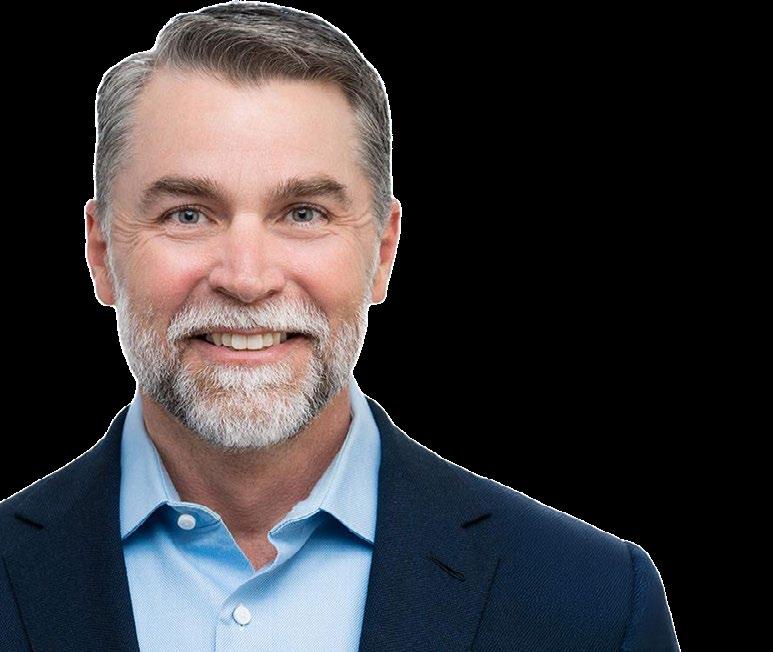
These investments enhance our operational efficiency and underscore our commitment to reducing emissions. And there’s more to come—we are excited to expand energy efficiency projects into additional sites across our growing portfolio.
Dennis Norman, Chief Financial Officer for Novolex
Novolex is committed to meeting our obligations under the terms of our SLF and credit agreement. With the recent acquisition of Pactiv Evergreen in April 2025, Novolex will reevaluate the company’s near- and long-term GHG emissions reduction goals and strategy as part of the ongoing integration process. Both Novolex and Pactiv Evergreen have taken meaningful steps to advance carbon reporting and goal setting in line with our customers’ expectations. This work will continue as a strategic priority for the combined companies. We expect to provide an update on our approach and progress in our next sustainability report.


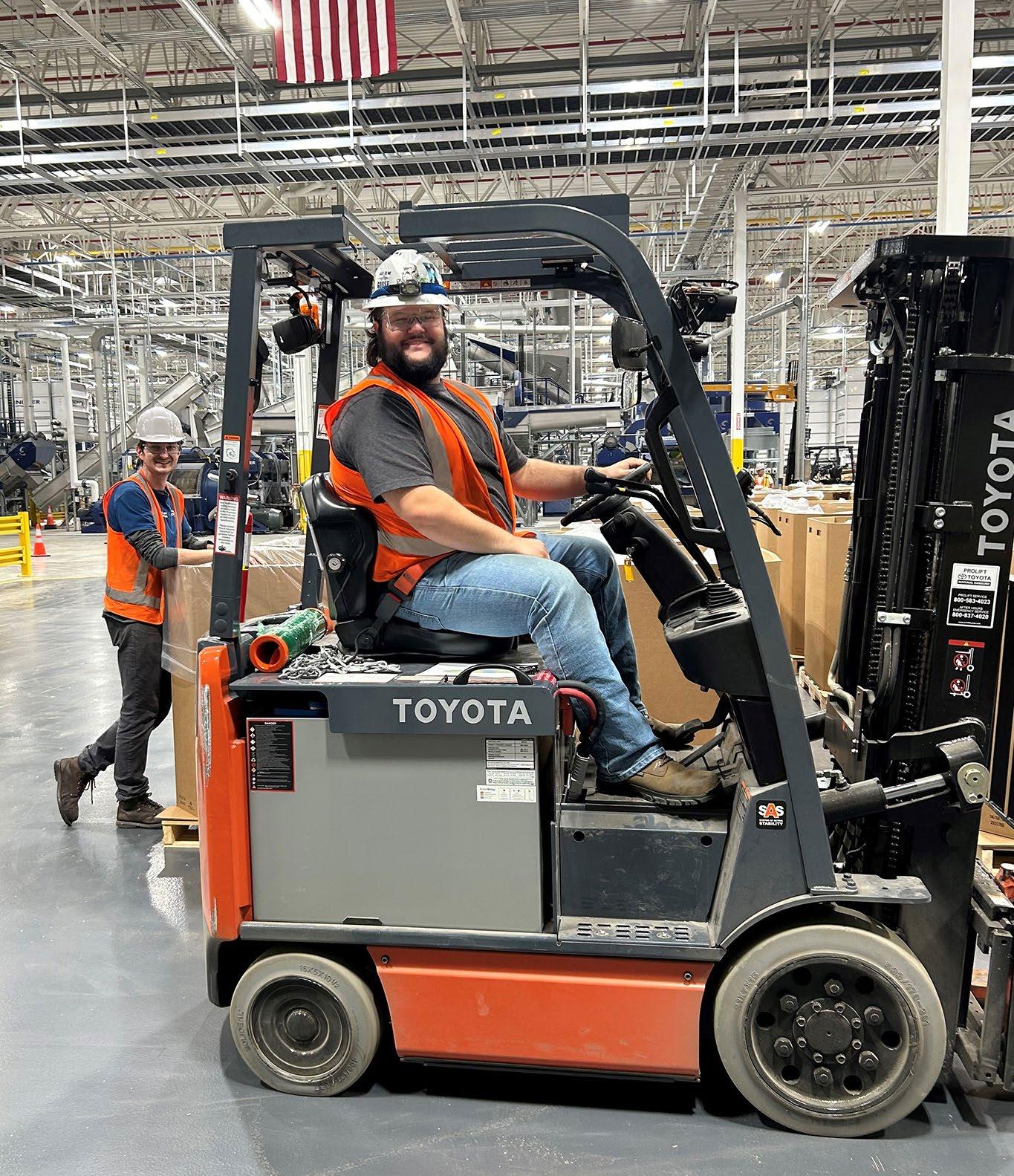
Energy use plays a significant role in Novolex emissions at our manufacturing facilities. On a rolling basis, we make continual investments in energy efficient technologies at our plants, including improvements to LED lighting; heating, ventilation and air conditioning (HVAC); chiller and boiler replacements; compressed air optimization; thermal insulation to retain heat as well as replacing major production equipment with new, more efficient options.
While other potential sources of emissions exist, such as the use of propane and gasoline for mobile combustion, refrigerant leaks from HVAC, and diesel back-up generators at some facilities, these sources are considered immaterial relative to our overall Scope 1 and 2 emissions, as defined by the GHG Protocol. As a result, they have been excluded from the scope of our GHG reduction target. As we move towards further alignment
with external reporting frameworks, we plan to build these sources into our emissions inventory and take steps to reduce them, such as installing two regenerative thermal oxidizers in the last three years.
In 2024, Novolex continued to monitor air emissions permits, with a focus on nitrogen oxides, sulfur oxides, volatile organic compounds and particulate matter, which vary by facility and process. Volatile organic compounds are primarily emitted from inks used in product printing, while nitrogen oxides and sulfur oxides result from natural gas usage, with propane also accounted for in our emissions reporting. In 2024, we continued to expand our air emissions reporting to include our Rio Bravo, Mexico facility and took steps to better quantify Scope 1 emissions from propane and diesel fuel usage, acknowledging the importance of tracking even small fuel volumes.
In 2024, Novolex achieved a significant milestone by completing a Scope 3 GHG inventory, a critical step in understanding and addressing our full carbon footprint. Over the past year, we identified our material Scope 3 categories, estimated their contributions to our overall Scope 3 emissions, and mapped out the approximate percentage each category represents using a combination of spend, volume and supplier-specific information. This work aligns with the GHG Protocol and reflects our commitment to transparency and accountability in measuring indirect emissions across our value chain.
The GHG Protocol groups all Scope 3 GHG emissions within one of 15 categories. The largest source of Novolex emissions fall under Category 1 which covers purchased goods and services and includes fiber and resin raw materials. Viewing raw material volume under the lens of emissions adds another meaningful layer to our ongoing supply chain work and informs our future direction in emissions reduction. Category 12 emissions cover the end-of-life treatment of products—whether they can be recycled, composted, reused or landfilled—and represents the second highest source of our Scope 3 footprint. Emissions from operations are included and represent approximately 8% of emissions. Understanding and addressing these emissions is a key focus as we work to reduce our overall environmental impact.
Moving forward, Novolex will continue to refine our Scope 3 inventory and engage with suppliers to improve the accuracy of reported data. These efforts will help us meet the evolving sustainability expectations of our customers and stakeholders while advancing the long-term sustainability of our industry.
Novolex GHG reduction objectives align with many of those held by our customers, who seek suppliers that share their sustainability goals. We meet our customers’ increasing needs by providing third-party verified, allocated emissions data from our operations as well as estimates for products through software-based PCF analysis. This information is becoming increasingly important to our customers as they assess their own Scope 3 emissions, including tracked
supplier emissions. Novolex aims to be ahead of the curve in supporting our customers with data. To support these efforts, Novolex and our customers evaluate product lifecycles to create accurate and meaningful carbon footprint assessments. We track new developments closely to help inform our stakeholders about the impact carbon uptake can have on the analysis of a product’s carbon footprint, limitations of LCA data and carbon accounting, particularly
for compostable materials. Novolex will continue to use tools, such as EcoImpact, and collect primary data to drive progress toward accurate and complete PCF data. While PCF data collection and modeling for molded fiber and bioplastics is in its infancy, the models in use today are constantly evolving as new data becomes available and scale improves, further enhancing our ability to address Scope 3 emissions across the value chain.
In 2024, Novolex continued to advance our monitoring and data collection efforts across operations to reduce waste and optimize water use. Under the oversight of the Director of Environmental Compliance, we managed environmental impacts across 56 manufacturing sites, working with local environmental, health and safety managers to develop action plans for waste and water mitigation.
2024 Waste Generated in Operations
We have continued to make progress in measuring our waste footprint, with more data now available on waste types and disposal methods per site.
The Sustainability Team also prioritized an updated water stress assessment using the World Resources Institute’s baseline tool.
Novolex generates a small amount of hazardous waste, accounting for less than 1% of our total waste footprint. We are committed to responsible management and tracking of hazardous waste for the safety of our employees, surrounding communities and environments where we operate.
To comply with regulatory requirements and manage waste effectively, certain Novolex facilities are required to maintain tracking, monitoring and management of hazardous waste generated onsite. At facilities that produce hazardous waste, we have implemented several initiatives, including solvent capture and reuse programs, aimed at reducing hazardous waste generation. 87% of tracked hazardous waste is combusted for energy recovery.
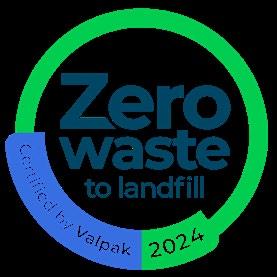
Note: In 2024, Novolex generated approximately 80 thousand metric tons of waste, the majority of which was recycled.
Our Waddington Europe business has been zero-waste certified by waste partner, Valpak, since 2020.
In July 2024, the Richwood, Kentucky plant, along with waste partner, Casella, helped identify opportunities to advance waste reduction and enhance recycling processes through a shift from using a compactor for paper waste streams, to shredding and baling those materials in-house. As a result, our Richwood location now bales an average of 270 tons of material that is sent directly to the mill for recycling. This change has led to a significant increase in material value per ton, monthly savings in hauling fees and a reduction in emissions associated with fewer compactor hauls.
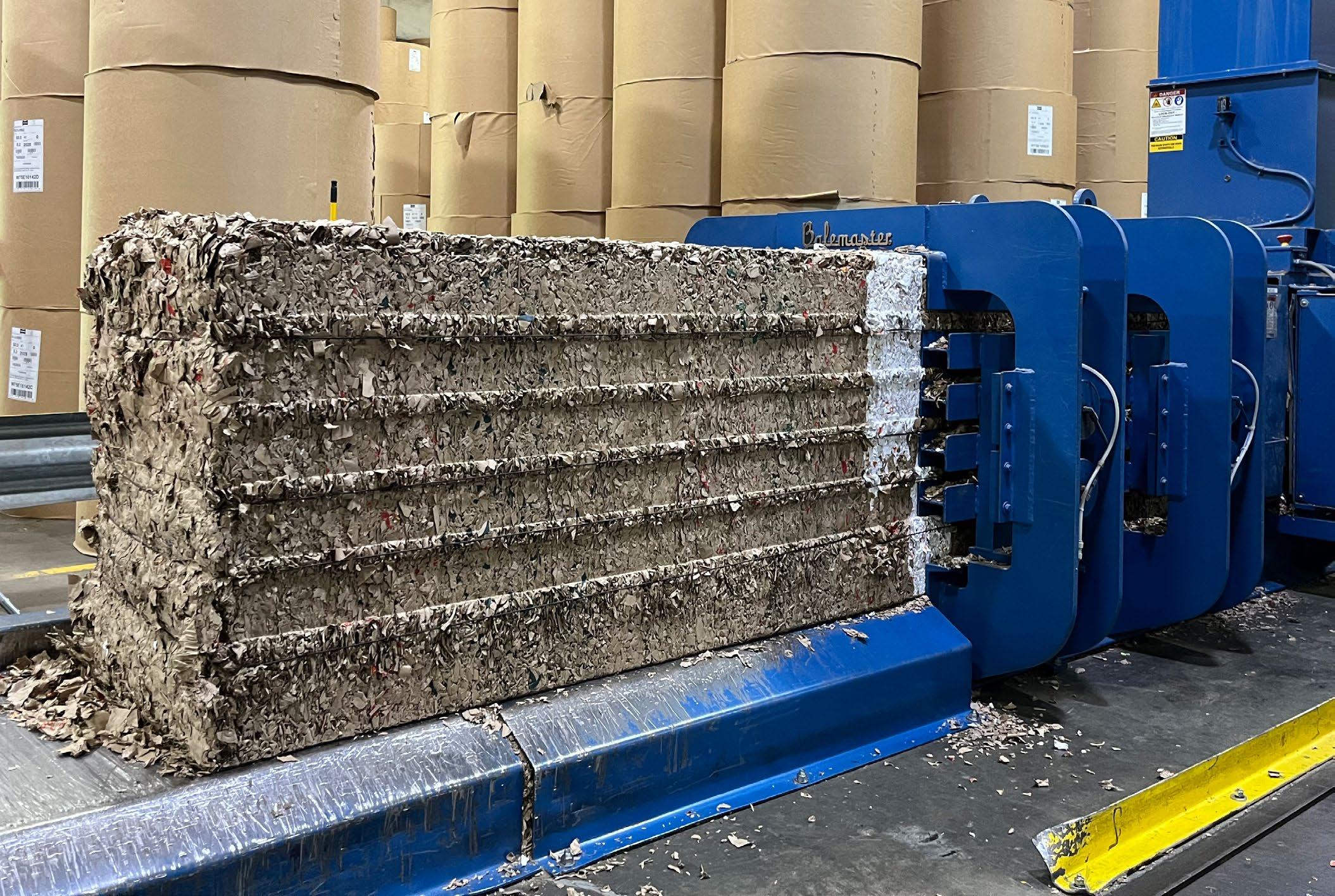
Following an assessment of waste management practices across the organization, we found that several facilities had strong waste management programs, but the approach varied from location to location. In response, we developed and piloted the Novolex Zero Waste Toolkit, an interactive, facility-level guide for waste management providing best practices and resources.
The toolkit is broken down into six steps which sites can follow to implement an effective Zero Waste Program and is customizable to a site’s own level of waste reduction processes. We will take lessons learned from the toolkit to improve our practices across additional facilities.


Ireland, the U.K. and the Netherlands

Very
Locations include manufacturing plants, warehouse and distribution centers and administrative offices.

Operation Clean Sweep (OCS) Blue is a program aimed at preventing resin loss into the environment. The Novolex Pellet Retention Program, which monitors, manages and eliminates pellet loss, reflects our commitment to OCS Blue principles. In early 2025, we earned our OCS Blue Badge, highlighting our leadership in responsible resin management. Novolex contributes to the development of OCS Blue verification standards through our role on the OCS Steering Committee within the Plastics Industry Association.
Novolex is dedicated to supporting industry-wide efforts to standardize training programs and conduct regular audits and inspections through our participation in OCS Blue. In 2025, we plan to conduct six verification audits as part of our ongoing responsibility to resin handling best practices across our facilities. We also engage with our contractors through a Pellet Retention Contractor Memo, which outlines best practices for pellet usage and stipulates that contractors must comply with national and local regulations regarding stormwater, wastewater and waste disposal.
At Novolex, our commitment to food and product safety begins at the highest levels of leadership and extends throughout the organization. To meet the expectations of our diverse customer base, all our employees in contact with food adhere to globally recognized standards, such as those set by the Global Food Safety Initiative (GFSI), which was created by 2,000 food industry leaders to reduce food safety risks and enhance trust in the supply chain. The Global Food Safety Initiative promotes continuous improvement in food safety management systems worldwide, and we remain dedicated to upholding these standards. For more information about food and product safety at Novolex, see our Food Safety webpage

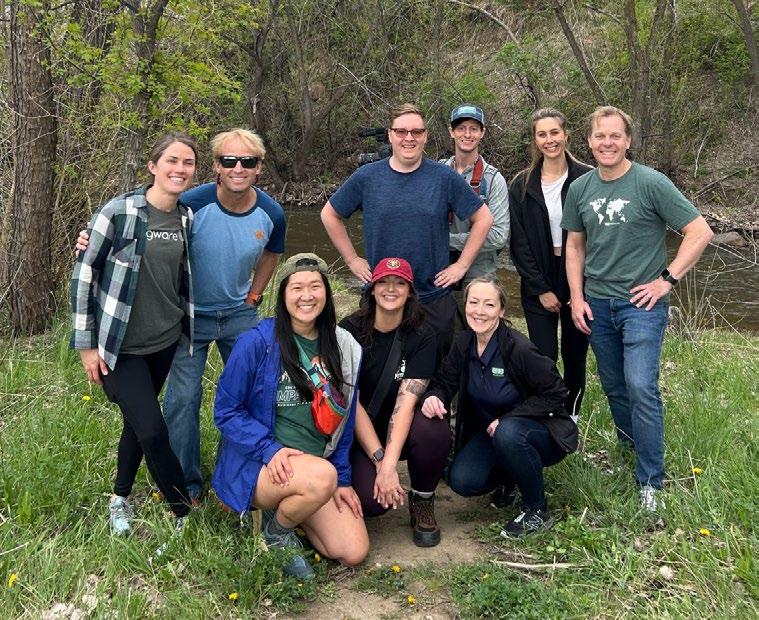

At Novolex, investing in our employees and the communities where we operate is fundamental to our core values. We are dedicated to fostering a workplace that prioritizes safety, ethical conduct, inclusivity, health and wellbeing and community engagement.

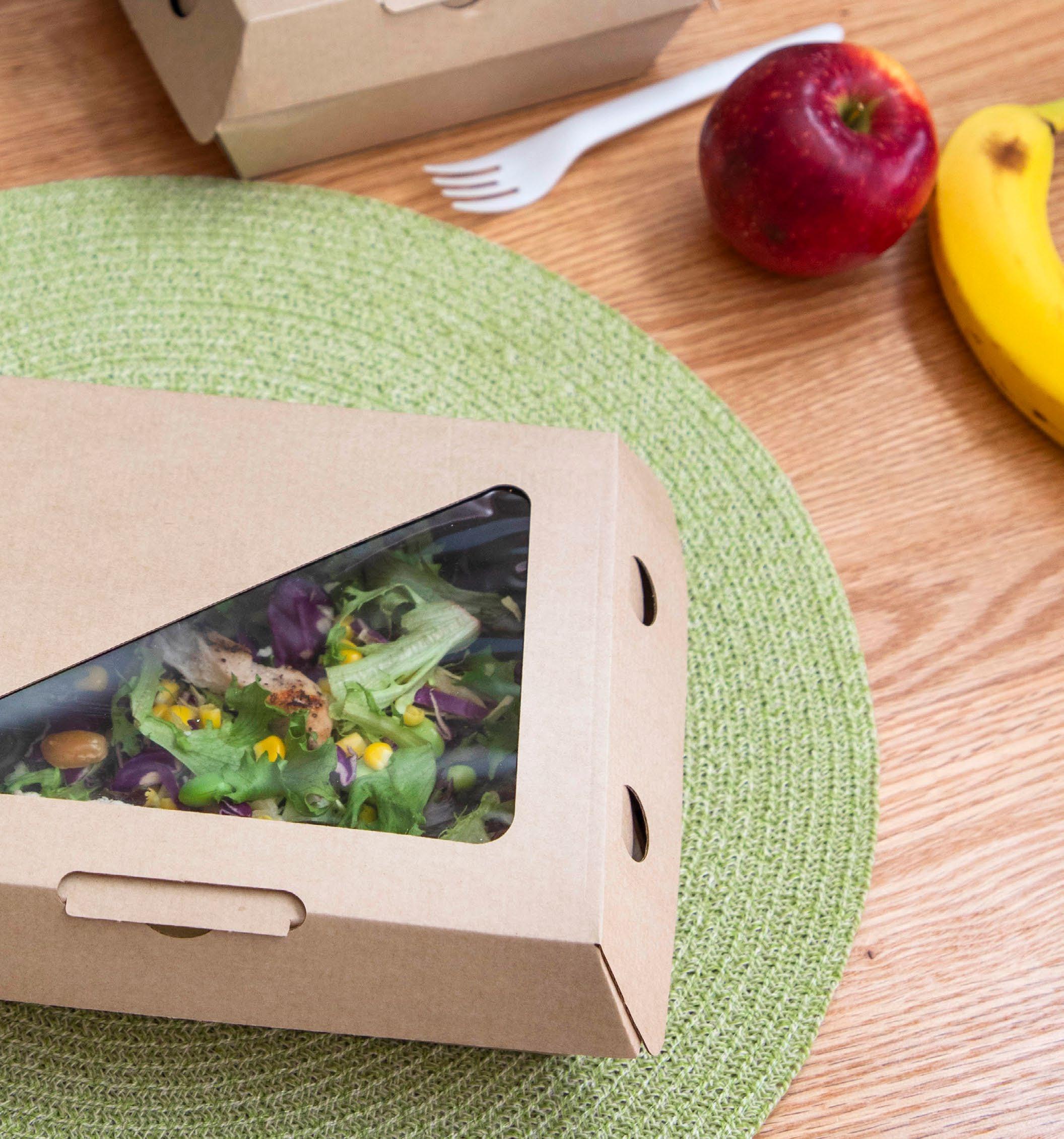
Underpinning our Novolex vision, pillars and metrics, all Novolex decisions and actions are guided by our values that promote a safe, fair and inclusive workplace while driving innovation and environmental stewardship. Our values are aligned with the seven Novolex Guiding Principles for good conduct and integrity that are embodied within the Novolex Employee Code of Conduct.

The wellbeing of our employees, customers and communities is our top priority, and we are committed to a safe and healthy work environment. This means prioritizing safety in all of our actions and decisions and continuously working to identify and mitigate potential hazards.
We hold ourselves to the highest ethical standards and work to ensure everyone is respected, accepted and supported. This means being accountable for our actions and doing the right and fair thing, even when it’s difficult.
We believe that working together as a team is the key to our success. This means valuing the unique differences of the people around us, actively seeking out the perspectives of others and ensuring everyone feels included.
We strive to be the best in everything we do, from the products and services we offer to the way we treat our customers, business partners and each other. This means continuously improving ourselves and our work and never being satisfied with mediocrity.
We are committed to constantly innovating and championing sustainable products, manufacturing practices and lifestyles. This means working with each other, our neighbors, customers and other stakeholders to support a circular economy.

At Novolex, safety is an integral part of our operations and is central to everything we do. Our focus on safety is strengthened by promoting the health and wellbeing of employees, which helps maintain a productive and resilient workforce. Guided by the Novolex Safety Handbook, we are committed to maintaining a safe and healthy work environment for all Novolex employees, suppliers and contractors. In 2024, we continued to enhance safety performance across the company. Our Health and Safety Management System played a crucial role in this effort, tracking policies, processes, procedures and performance. The system supports efficient management of inspections, incident investigations and the implementation of corrective and preventative actions. To ensure continuous improvement, the S&EHS Committee of the Novolex Board of Directors reviews
safety performance and program progress on a quarterly basis, reinforcing our commitment to safety at the highest levels of the organization.
Novolex consistently maintains a Total Recordable Incident Rate (TRIR) below the industry average, as defined by Occupational Safety and Health Administration guidelines and Bureau of Labor Statistics data. In 2024, our TRIR decreased to 1.75, the lowest in the history of the organization, compared to a TRIR of 2.3 in 2023. Employees continue to create better and safer tasks and procedures, which are crucial for continuous improvement. We focused our efforts in 2024 on improving safety by applying safety strategies that meet and exceed industry standards.

Building a culture of safety starts at the top and flows down through every level of the organization. That means everyone shares in the ownership for improved safety performance.
Courtney Kuykendall, Director, Safety
Safety is a fundamental aspect of every operation at Novolex, with a strong focus on the wellbeing of employees, contractors, customers and the communities we serve. Our safety teams monitor safety measures across the organization while continuously investing in processes to minimize risk and potential incidents. We encourage all employees to adopt a “safety always” approach, promoting a culture of open communication and accountability.
1.75
Novolex TRIR in 2024 was 1.75 compared to 2.3 in 2023. 1.75 is the lowest TRIR in the history of the organization.
We encourage employees to report work-related hazards through multiple channels, including regular Plant Safety Committee meetings, anonymous suggestion boxes at each facility and the confidential Novolex Ethics and Compliance Hotline. Monthly safety committee meetings bring together management and production floor employees, fostering direct and open communication. Backed by the Novolex Ethics and Integrity Speak-Up Policy, our open-door approach allows all employees to freely voice safety concerns with their supervisors without fear of reprisal. In addition, employees receive ongoing safety training, toolbox talks and regular assessments to help maintain a safe workplace.

In 2024, we continued to build upon the success of our “Good Catch” program to engage with employees on the production floor. The program encourages employees to report near misses, suggest areas for improvement and recognize colleagues who demonstrate outstanding efforts in creating a safe work environment.
As part of the Good Catch Program, in which employees report near-misses and recognize “Safety Heroes,” nearly 14,000 submissions have been made since the program’s inception in 2023. Rather than hide a near miss which could reflect poorly on the employee involved or who witnessed it, the program rewards transparency and encourages everyone to identify hazardous conditions so that they can be fixed, or insufficient procedures so that they can be improved.
In 2024, we continued to advance our transformation through the Human Performance (HP) journey. By applying HP principles, we focus on understanding the interactions between people, culture, equipment, processes and systems by implementing defenses to prevent incidents, reduce risk and enhance our safety culture. Our Environmental, Health and Safety Training Manager provides customized HP training materials and tools. Monthly HP Champion virtual meetings are a key avenue for our plant managers and their safety professionals to collaborate and exchange best practices.
Every June, Novolex celebrates National Safety Month, which marks a milestone in the commitment to safety and the integration of HP principles. As of June 2024, over 600 employees have been trained as HP Champions, and Novolex is seeing a significant shift in safety culture.
In addition to HP training, employees engage in a comprehensive range of safety trainings using courses available in the Novolex University Learning Management System, “toolbox talks,” shift safety meetings, onboarding sessions for new hires, refresher courses and site-specific training. Plant leadership teams conduct Gemba Walks on the production floor, and employ audits, periodic risk assessments and other methods to identify and address potential hazards in both production and distribution facilities.
This past year, Novolex also conducted full learning team events to help conduct safety evaluations to supplement traditional safety incident investigations.
Novolex remains committed to upholding the highest ethical standards for business conduct throughout the entire organization and within our supply chain. The Novolex Employee Code of Conduct and Novolex Supplier Code of Conduct as well as associated policies, programs and procedures clearly outline and set forth our expectations for ethical business conduct.
The seven principles of the Novolex Employee Code of Conduct outline clear expectations for ethical employee behavior and guide the company’s commitment to ethical business conduct. All new employees are required to review and sign an acknowledgment, confirming their understanding of and agreement to uphold the code. In addition, every employee must annually reaffirm that they understand and agree to comply with the code.
At Novolex, we actively encourage our employees to engage in open communication about operations, safety and compliance concerns. We believe our employees are our greatest resource for insights and ideas on how we can continuously improve, whether by enhancing safety, boosting efficiency, improving product quality or reducing energy consumption. Our open-door approach to communicating is detailed in our employee handbook and encourages colleagues to speak up in production team shift change meetings, one-on-one interactions with supervisors, with Human Resources representatives or others. The Novolex Safety Handbooks for salaried and for non-salaried employees were updated in 2024. In addition, the Novolex Ethics & Integrity Speak-Up Policy provides a framework through the Ethics and Compliance Hotline for employees to report concerns that they do not feel comfortable raising with leadership. The policy assures that calls or emails to the hotline are received and assessed in confidence and prohibits retaliation against employees who use the hotline in good faith. Posters advertising the hotline and how to use it are displayed in all company facilities.
Novolex maintains a zero-tolerance policy regarding the use of illegal, forced, or involuntary labor, human trafficking, child labor and unfair or discriminatory labor practices.
Our Human Rights Policy outlines our commitments and procedures to safeguard human rights, aligning with globally recognized declarations and covenants, including The International Bill of Human Rights and the International Labor Organization’s Declaration on Fundamental Principles and Rights at Work. The Novolex Modern Slavery Statement complements our Human Rights Policy, citing the U.K.
Modern Slavery Act 2015, the California Transparency in Supply Chains Act, the Dutch Child Labour Due Diligence Law and the Canada Forced Labour and Child Labour in Supply Chains Act.1 We train our Human Resources, Procurement and International Trade Compliance professionals on our Human Rights Policy. Our policy and efforts help assure our stakeholders of the Novolex commitment to protecting human rights. We acknowledge that inadequately managing human rights issues could have adverse impacts on the workers directly involved, our employees, contractors, suppliers, customers and others.
1 In 2025, Novolex reported on 2024 activities undertaken in compliance with the Act.


At Novolex, we view our suppliers as essential partners in the success of our business, and we expect them to align with our commitment to human rights and other sustainability-related practices. The Novolex Supplier Code of Conduct outlines our expectations in areas such as human rights, labor practices, environmental responsibility and management practices. All Novolex suppliers are required to acknowledge and agree with the code upon onboarding through the Coupa supplier management platform. In 2024, more than 99% of all applicable1 onboarded suppliers confirmed their commitment to the code.
Novolex contractual terms require suppliers to comply with the code, with non-compliance potentially leading to corrective actions, third-party audits and contract termination. To maintain transparency, we provide suppliers and their employees with access to the Novolex Ethics and Compliance Hotline, offering a confidential channel to report concerns. Applicable members of the Novolex Procurement organization completed training on the code, and new hires within the Procurement organization complete the training as part of their orientation.
1 Excluded organizations include utilities, philanthropies or other nonprofits and government entities. Some suppliers that had their own codes of conduct adequately covering the issues addressed in the Novolex code also did not sign.
At Novolex, we proactively manage potential supply chain risks using the Intertek Inlight™ end to end Supplier Qualification Operating System. This system evaluates a range of risk factors to identify suppliers based in countries with high inherent risks. We determine high inherent risk countries based on risk scores from the World Bank Governance Indicators, the U.N. Human Development Index, the Transparency International Corruption Index and the U.S. State Department Trafficking in Persons Report. Supply chain due diligence is further reinforced by the Novolex Trade Sanctions Policy, which governs all imports and exports and applies to interactions associated with countries subject to embargoes or trade sanctions.
In 2024, Novolex continued to enforce the company’s Forced Labor Prevention Program, a key initiative for identifying risks and mitigating the use of forced labor in our supply chain. The program complies with the U.S. Uyghur Forced Labor Prevention Act, prohibiting imports of goods suspected to have been mined, produced, or manufactured in China’s Xinjiang Uyghur Autonomous Region. The program also supports similar regulations from other jurisdictions in which we or our suppliers operate.
The success of Novolex is built on the empowerment and wellbeing of our employees. With a global workforce of more than 10,000 individuals, the Novolex family is the heart of our operations, driving innovation and growth through their dedication and expertise. We are committed to providing our employees with meaningful career development opportunities so they feel valued and supported in our inclusive work environment. The unique backgrounds and perspectives of our employees position Novolex for long-term success.
At Novolex, we recognize that investing in employee development is key to cultivating a winning, entrepreneurial mindset and creating rewarding career paths. In 2024, we continued to expand our learning and development initiatives, enhancing our offers to include on-the-job developmental assignments, e-learning courses and best-in-class, in-person training programs through Novolex University. We offer a range of training programs including safety; soft skills; job skills; commercial excellence; compliance; diversity; leadership development; operational excellence and orientation and onboarding.
We added a new member to our Learning & Development Team, which focuses on talent development and training. We also maintain a strong focus on talent development through annual performance evaluations, talent reviews and continuous one-on-one feedback sessions so our employees are prepared for increased roles and responsibilities.
As part of our ongoing commitment to employee development, we encourage all Novolex team members to deepen their understanding of how sustainability applies to Novolex. Through a variety of communication channels, sustainability education at Novolex covers key topics such as product design, composting and recycling labeling, customer sustainability targets, carbon emissions and developments related to raw material sustainability.
Our Talent Acquisition Team incorporates best practices into our recruiting processes and received training in 2024 to minimize bias in job descriptions. Additionally, in 2024, we continued to require annual training for all hiring managers to minimize bias during the hiring process, resulting in tangible progress with increased representation of women and people of color across the organization.
Novolex recruiters participate in the National Black MBA Association’s Job Recruitment Fair, connecting with multiple prospective applicants. We also engage in veterans’ job fairs, providing opportunities to connect with individuals who serve our country, with the aim of hiring them for full-time employment.

194,000
In 2024, employees logged more than 194,000 training hours company-wide, up from approximately 145,000 in 2023.
44%
In 2024, we continued our focus on promoting from within, with an average of 44% of our open salaried positions filled with internal promotions.
The Novolex Culture and Engagement strategy rests on five pillars designed to touch all facets of our business and foster a workplace that mirrors the communities in which we operate. Our Culture and Engagement programs cultivate an environment where everyone feels included regardless of identity or background.
The Leadership Commitment & Accountability Pillar includes our Novolex Culture and Engagement Council, led by company leaders who provide governance, guidance and support, aligning our programs and activities with Novolex talent strategies and objectives. Council members provide leadership through culture and engagement initiatives, amplifying operations, identifying potential barriers and sharing best practices within their organizational areas. The Novolex Chairman and CEO and Chief Human Resources Officer serve as the Culture and Engagement Council sponsors.
Reflecting our long-standing commitment to a culture where every employee has the opportunity to thrive, in 2024 women or people of color made up 40% of our top 60 leaders and 31% of our plant managers (U.S. and Canada only). The diversity of our leadership team demonstrates both to colleagues and our communities that Novolex provides opportunities for growth and development for people of all identities and experiences.

In order to ensure that we continue to grow in our culture and engagement journey, we have established a Culture and Engagement Council that drives programming, strategy and goals. The Council is made up of top leaders from across the company. Additionally, leaders across the company will also begin to develop culture and engagement-focused goals for their teams.

In order to attract the best diverse talent to Novolex, we have implemented engagement and inclusivity practices in our recruiting processes. This includes training recruiters on how to remove bias from job descriptions as well as training recruiters and hiring managers on how to make less biased hiring decisions. We also examine our processes to better track candidates and work to develop a strong external employer brand to enhance our ability to attract great candidates.

In order to advance efforts that increase the retention and advancement opportunities for the diverse talent within the company, we are deploying training programs to help emphasize the benefits of and opportunities for internal promotion. We also ensure that engagement and inclusive practices are embedded in our Talent Review and Development processes.

In order to foster a culture where our people feel respected, accepted and supported, we work closely with the Culture and Engagement Council to develop consistent programming that recognizes cultural identities and their unique contributions to the Novolex community. We also listen to our Novolex family and gather input on additional programs and support systems to help make everyone feel a sense of belonging.

In order to develop and build supplier partnerships that reflect greater diversity, our Procurement team will identify and create opportunities to select diverse suppliers across our value chain. A Procurement team representative is a member of the Culture and Engagement Council to help ensure we optimize diverse businesses in our supply chain.

In July, Plastic News unveiled its 2024 Women Breaking the Mold Special Report, highlighting influential women in the plastics industry. Among the honorees were Kim Witte, Director of Sales for HeritageTM Bag, a Novolex brand, and Donna Cartwright, Senior Director of Technology at Novolex. These two individuals exemplify leadership, passion and mentorship.
Kim’s journey began in sales, where her interest in addressing misconceptions about plastics led her to focus on educating consumers about the importance of sustainable products. With over a decade of experience, Kim excels at building connections and mentoring others.
Donna’s path, marked by perseverance and education, reflects her dedication to her career and her family. Donna has helped develop innovative products by securing three patents and earning multiple awards. Her career is also shaped by mentorship, with strong support from leaders like Adrianne Tipton, Novolex Chief Innovation and Sustainability Officer.
Our Broad-Based Employee Award Program recognizes employees’ contributions to the growth of the company. The plan enables eligible employees to participate in the success and growth of the company through a potential cash award based on an increased valuation of Novolex over time. The benefit is available to all employees after completing one year of service.
At Novolex, we believe that healthy employees are safer, happier and more productive. This philosophy drives the foundation of our benefits program, which is designed to support the overall wellbeing of our Novolex family. In most countries outside the U.S., we offer benefits that enable our employees to receive comprehensive care to supplement national health programs. Each year, we carefully monitor, evaluate and adjust benefits to meet the evolving and diverse needs of our employees and their families.
The Novolex Chairman’s Scholarship Program annually awards partial four-year scholarships to five children of employees based in the U.S., allowing them to pursue post-secondary education at schools of their choice. A dedicated employee panel reviews all applications and selects the winners. The following are our 2024 scholarship recipients.

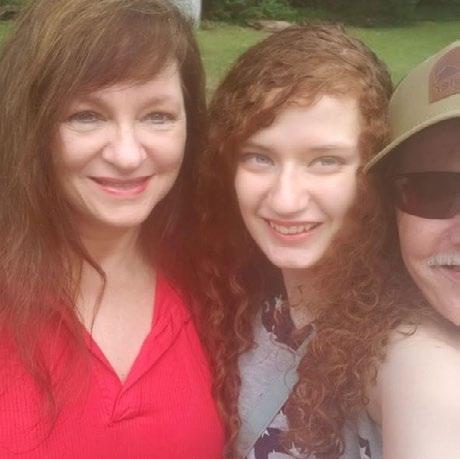
Daughter of Phillip Niswonger in Jackson, Tennessee
Meloney Niswonger is attending Jackson State Community College for her basic classes and Pre Occupational/Physical Therapy Program and plans to transfer to the University of Memphis Lambuth to receive a degree in physical therapy.

Son of Maria Valdes in Katy, Texas
Alex Valdes is currently majoring in biology at the University of Texas at San Antonio and plans to become a veterinarian.

Daughter of Olga Beatriz Justavino Doss in Baxter Springs, Kansas
Stephanie Simpson is attending the University of Oklahoma as a graphic design and communications major. Stephanie would love to design logos for brands and be a design director.

Son of Tanya Songer in Florence, Kentucky
Roland Songer will be attending the University of Kentucky as a business major.

Daughter of Adolfo Garcia in Yakima, Washington
Evelyn Garcia will be attending Yakima Community College working towards a degree in nursing.
Novolex remains committed to engaging with the communities where we operate by contributing both donations and volunteer efforts. Our Focused Giving Program directs support to organizations that align with our businesses, products and values. We concentrate our efforts on nonprofits that address food and hunger needs, sustainability and health and wellness.
In addition to providing financial support to diverse community programs, we extend our impact with in-kind donations of Novolex products such as utensils, plates, cups and bags to local nonprofit organizations. Our giving campaigns impacted 846 unique organizations through product and monetary donations and by hosting 136 community engagement events. These donations help us meet immediate community needs, making a positive impact in the lives of those we serve.
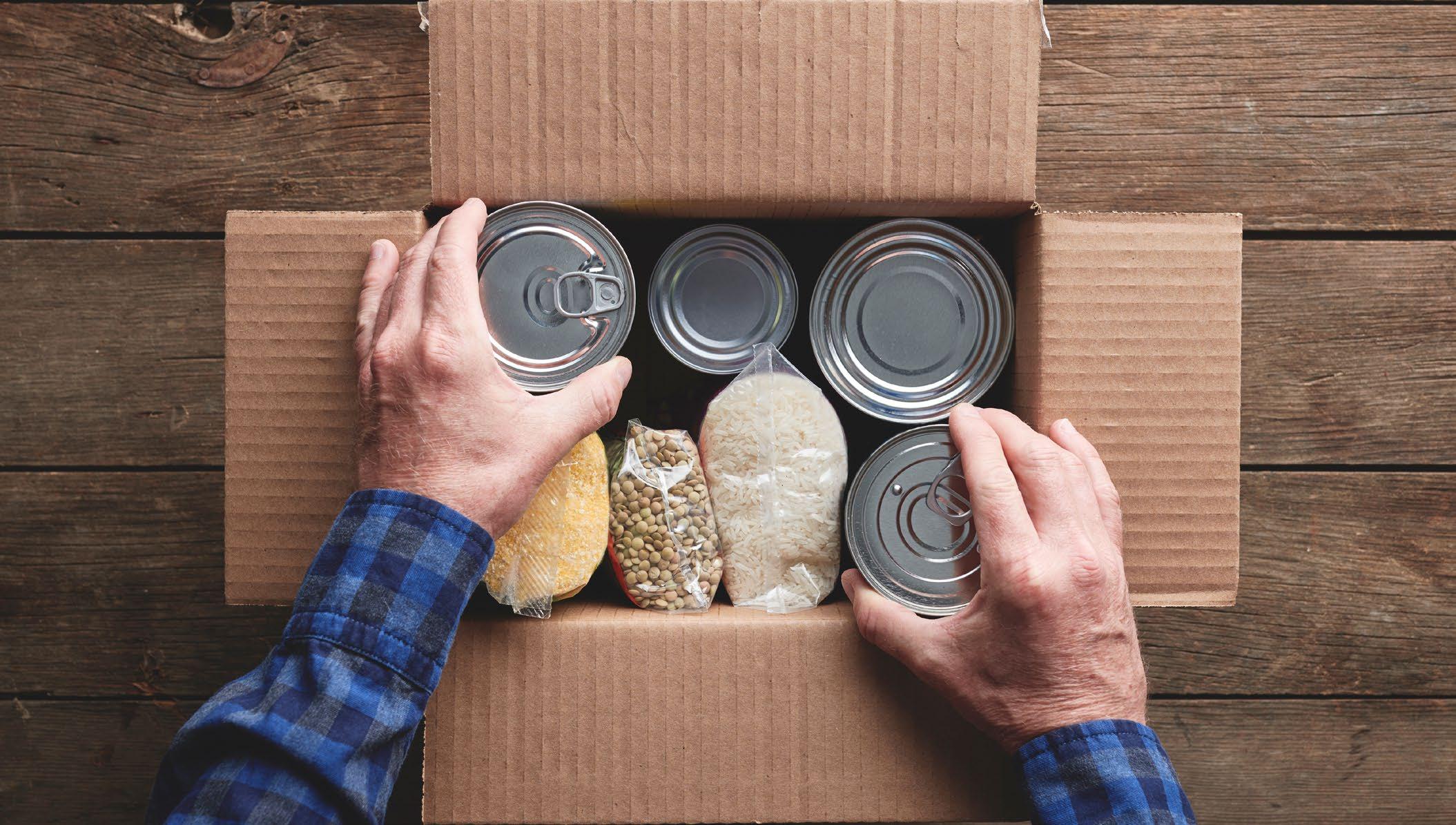
Novolex continued the No Hunger Holidays campaign in 2024, donating funds and products to our long-standing partner, Feed the Children.



In honor of Earth Day and Arbor Day, Novolex supported the Arbor Day Foundation’s Community Canopy program through a donation. In appreciation, the Arbor Day Foundation supplied Novolex with 200 trees for employees to plant in their communities. Participating Novolex employees can use the foundation’s online tool to identify optimal tree-planting locations for maximum energy savings and monitor the tree’s growth. For employees in communities unable to receive trees by mail, the Arbor Day Foundation plants a tree on their behalf, eliminating barriers for our employees to engage in this meaningful event.
In September, we partnered with the Ronald McDonald House Charities in alignment with our Health & Wellness Giving Pillar. Through its global outreach, the Ronald McDonald House extends assistance to communities by providing shelter, education and meals to families while their children receive medical care. The Novolex partnership with the Ronald McDonald House Charities supports the outstanding work of the organization whose mission is to create, find and support programs that directly improve the health and wellbeing of children.





In 2020, Novolex partnered with a top sustainability consultancy to conduct a materiality assessment. This process helped us identify and prioritize the topics most critical to our business and stakeholders, resulting in 23 key topics, including nine high-priority Tier 1 topics. These Tier 1 topics have shaped the disclosures in this report, align with the Sustainability Accounting Standards Board’s Containers & Packaging industry standard and are reflected in our Global Reporting Initiative content index on the following pages. The content index outlines Novolex disclosures according to the Global Reporting Initiative standards, unless otherwise specified. Novolex reports in line with the 2021 Global Reporting Initiative universal standards.
The Organization and Its Reporting Practices
2-1 Organizational details a. Legal name.
b. Nature of ownership and legal form.
c. Location of headquarters.
d. Countries of operation.
2-2 Entities included in the organization’s sustainability reporting
2-3 Reporting period, frequency, and contact point
a. Entities included in sustainability reporting.
b. Differences between the entities included in its financial reporting and the entities included in sustainability reporting.
c. If the organization consists of multiple entities, explain the approach used for consolidating information:
i. Whether the approach involves adjustments to information for minority interests;
ii. How the approach takes into account mergers, acquisitions, and disposal of entities or parts of entities;
iii. Whether and how the approach differs across the disclosures in this Standard and across material topics.
a. Reporting period for and frequency of sustainability reporting.
b. Financial reporting period and, if it does not align with the period for sustainability reporting, explaining the reason for this.
c. Publication date of the report or reported information.
d. Contact point for question about the report or reported information.
a. Sustainability Vision, Pillars & Metrics, p. 08
b. Governance, pp. 09–10
c. Charlotte, North Carolina.
d. Novolex maintains operations in the U.S., Canada, Mexico, the U.K., Ireland, and the Netherlands.
a. The reporting entity, Novolex Holdings, LLC (Novolex), is majority owned and controlled by affiliates of Apollo Global Management through a holding company structure in which the Board Directors of our ultimate parent company is our highest governance body. The reporting covers the activities of Novolex Holdings, LLC and its subsidiaries. See also, Governance, p. 10
b., c. (i, ii, iii.) b. Not applicable.
c. Not applicable.
b. Novolex is privately held and financial information is not a matter of public record.
c. Novolex Holdings LLC is the consolidating entity.
a. The reporting period is January–December 2024; Novolex publishes a sustainability report annually.
b. The financial reporting period is January–December 2024; the sustainabiity report is not required to align with the date of the company’s financial report which is not public.
c. This report was published in 2025 and covers activities that principally occurred in 2024.
d. Novolex Approach to Sustainability, p. 04
2-4 Restatements of information
a. Restatements of information made from previous reporting periods:
i. The reasons for the restatements;
ii. The effect of the restatements.
2-5 External assurance
a. Policy and practice for seeking external assurance, including whether and how the highest governance body and senior executives are involved.
b. If the organization’s sustainability reporting has been externally assured:
i. Provide a link or reference to the external assurance report(s) or assurance statement(s);
ii. Describe what has been assured and on what basis, including the assurance standards used, the level of assurance obtained, and any limitations of the assurance process;
iii. Describe the relationship between the organization and the assurance provider.
None.
a. The company’s sustainability-linked financing requires third-party assurance of annual greenhouse gas (GHG) emissions data which are reviewed by Novolex senior management. The sustainability report is not assured by a third party.
b. i. The Report of Independent Accountants provides assurance of GHG emissions data. Novolex 2024 Limited Assurance Report
ii. The scope of the assurance covers greenhouse gas (GHG) emissions, total energy consumption, and emissions intensity. The assurance was conducted in accordance with attestation standards established by the American Institute of Certified Public Accountants (AICPA) in AT-C section 105, Concepts Common to All Attestation Engagements, and AT-C section 210, Review Engagements. The assurance relies on information provided by Novolex and considers the principles and guidance of the World Resources Institute (WRI) and the World Business Council for Sustainable Development’s (WBCSD), The Greenhouse Gas Protocol: A Corporate Accounting and Reporting Standard, Revised Edition and the GHG Protocol Scope 2 Guidance: An amendment to the GHG Protocol Corporate Standard (together, the “GHG Protocol”) to guide the criteria to assess, calculate, and report total Scope 1 and 2 emissions, total energy consumption as well as emissions intensity.
iii. We engaged an external third-party to perform an attest review engagement for scope 1 emissions, scope 2 (location and market based) emissions, total energy consumption, and emission intensity disclosed within this Sustainability Report as of December 31, 2024, and for the year then ended. Activities and Workers
2-6 Activities, value chain, and other business relationships
a. Report the sector(s) in which it is active.
b. Describe the value chain, including:
i. activities, products, services, and markets served;
ii. the supply chain;
iii. the entities downstream from the organization and their activities.
c. Other relevant business relationships.
d. Significant changes in a, b, and c compared to the previous reporting period.
a. Novolex Company Overview Webpage
b. Novolex Company Overview Webpage; Sustainability Vision, Pillars & Metrics, p. 08
c. Policies & Partnerships, How We Engage, p. 20
d. No significant changes in a, b, and c. compared to the previous reporting period.
2-7 Employees a. Total number of employees, broken down by gender and region.
b. Total number of:
i. permanent employees by gender and region;
ii. temporary employees by gender and region;
iii. non-guaranteed hours employees by gender and region;
iv. full-time employees by gender and region; and
v. part-time employees by gender and region.
c. Methodologies and assumptions used to compile the data, including:
i. whether the numbers are in head-count, full-time equivalent, or another methodology;
ii. at the end of the reporting period, as an average across the reporting period, or another methodology.
d. Contextual information necessary to understand the data.
e. Significant fluctuations in the number of employees during the reporting period and between reporting periods.
2-8 Workers who are not employees
a. Total number of workers who are not employees whose work is controlled by the organization, including:
i. the most common types of works and contractual relationship to the organization; and, ii. the type of work they perform.
b. Methodologies and consumptions used to compile the data, including:
i. whether the numbers are in head-count, full-time equivalent, or another methodology;
ii. at the end of the reporting period, as an average across the reporting period, or another methodology.
c. Significant fluctuations in the number of workers who are not employees during the reporting period and between reporting periods.
a. People & Communities, p. 29
b. People & Communities, p. 29
c. i. The methodology used to compile the data is head-count.
ii. The head-count data reflects permanent employees at the end of the reporting period.
d. Contextual information is not required.
e. There are no significant fluctuations in the number of employees during the reporting period.
a. 494 retained via local employment agencies principally for production facilities.
b. Numbers are in FTE (40 hrs/wk); some may convert, others are seasonal, and none are on benefits.
c. Numbers may fluctuate due to seasonality.
2-9 Governance structure and composition
a. Describe its governance structure, including committees of the highest governance body.
b. List the committees of the highest governance body that are responsible for decision-making on and overseeing the management of the organization’s impacts on the economy, environment, and people.
c. Describe the composition of the highest governance body and its committee:
i. Executive and non-executive members;
ii. Independence;
iii. Tenure of members on the governance body;
iv. Number of other significant positions and commitments held by each member, and the nature of the commitments;
v. Gender;
vi. Under-represented social groups;
vii. Competencies relevant to the impacts of the organization;
viii. Stakeholder representation.
2-10 Nomination and selection of the highest governance body
a. Describe the nomination and selection processes for the highest governance body and its committees;
b. Describe the criteria used for nominating and selecting highest governance body members, including whether and how the following are taken into consideration:
i. Views of stakeholders (including shareholders);
ii. diversity;
iii. independence;
iv. competencies relevant to the impacts of the organization.
a. The reporting entity, Novolex Holdings, LLC (Novolex), is majority owned and controlled by affiliates of Apollo Global Management through a holding company structure in which the Board Directors of our ultimate parent company is our highest governance body. See also, Governance, p. 10
b. Governance, p. 09
c. Governance, p. 09 ; The Board includes two members who are female.
constraints.
a. The members of the Board were nominated by the principal shareholders. The members of the committees of the Board were selected by the Board.
b. The criteria for nominating and selecting the members of the Board took into consideration:
i. the views of stakeholders (including shareholders);
ii. diversity;
iii. independence; and
iv. competencies relevant to the impacts of the organization.
2-11 Chair of the highest governance body
a. Report whether the chair of the highest governance body is also a senior executive.
b. If the chair is also a senior executive, explain their function within the organization’s management, the reasons for this arrangement, and how conflicts of interest are prevented and mitigated.
2-12 Role of the highest governance body in overseeing the management of impacts
a. Describe the role of the highest governance body and of senior executives in developing, approving, and updating the organization’s purpose, value or mission statements, strategies, policies, and goals related to sustainable development.
b. Describe the role of the highest governance body in overseeing the organization’s due diligence and other processes to identify and manage the organization’s impacts on the economy, environment, and people, including:
i. whether and how the highest governance body engages with stakeholders to support these processes;
ii. how the highest governance body considers the outcomes of these processes;
c. Describe the role of the highest governance body in reviewing the effectiveness of the organization’s processes as described in 2-12-b, and report the frequency of this review.
2-13 Delegation of Responsibility for managing impacts
a. Describe how the highest governance body delegates responsibility for managing the organization’s impacts on the economy, environment, and people, including:
i. Whether it has appointed any senior executives with responsibility for the management of impacts;
ii. whether it has delegated responsibility for the management of impacts to other employees;
b. Describe the process and frequency for senior executives or other employees to report back to the highest governance body on the management of the organization’s impacts on the economy, environment, and people.
a. Governance, pp. 09–10
b. The Chair of the Board is also the Chief Executive Officer and responsible for oversight of daily operations. He brings to both roles extensive experience in packaging. Any potential conflicts of interest are mitigated through oversight provided by other members of the Board.
a. Governance, pp. 09–10
b. Governance, pp. 09–10
c. Governance, pp. 09–10
a. Governance, pp. 09–10
b. Governance, pp. 09–10
2-14 Role of the highest governance body in sustainability reporting a. Report whether the highest governance body is responsible for reviewing and approving the reported information, including the organization’s material topics, and if so, describe the process for reviewing and approving the information.
b. If the highest governance body is not responsible for reviewing and approving the reported information, including the organization’s material topics, explain the reason for this.
2-15 Conflicts of interest
a. Describe the processes for the highest governance body to ensure that conflicts of interest are prevented and mitigated.
b. Report whether conflicts of interest are disclosed to stakeholders, including, at a minimum, conflicts of interest relating to:
i. cross-board membership;
ii. cross shareholding with suppliers and other stakeholders;
iii. existence of controlling shareholders;
2-16 Communication of critical concerns
a. The S&EHS Committee of the Board reviews and is given an opportunity to provide feedback to the Senior Leadership Team prior to publication of the report.
b. Not applicable. Novolex S&EHS Board Committee reviews our annual sustainability report prior to publication.
2-17 Collective knowledge of the highest governance body
2-18 Evaluation of the performance of the highest governance body
iv. related parties, their relationships, transactions, and outstanding balances. a., b. (i., ii., iii., iv.) Confidentiality constraints. Novolex is privately held and this information is not a matter of public record.
a. Describe whether and how critical concerns are communicated to the highest governance body.
b. Report the total number and the nature of critical concerns that were communicated to the highest governance body during the reporting period.
a. Report measures taken to advance the collective knowledge, skills, and experience of the highest governance body on sustainable development.
a. Critical concerns can be communicated by the Senior Leadership Team during quarterly meetings of the Board or Audit Committee or at other times as needed if matters of concern arise.
b. Confidentiality constraints.
a. Describe the processes for evaluating the performance of the highest governance body in overseeing the management of the organization’s impacts on the economy, environment, and people.
b. Report whether the evaluations are independent or not, and the frequency of the evaluations.
c. Describe actions taken in response to the evaluations, including changes to the composition of the highest governance body and organizational practices.
a. Governance, pp. 09–10
a., b., c. Confidentiality constraints.
Novolex is privately held and this information is not a matter of public record.
Novolex is privately held and this information is not a matter of public record.
2-19 Remuneration policies
a. Describe the remuneration policies for members of the highest governance body and senior executives, including:
i. Fixed pay and variable pay;
ii. Sign-on bonuses or recruitment incentive payments;
iii. Termination payments;
iv. Clawbacks.
v. Retirement benefits.
b. Describe how the remuneration policies for members of the highest governance body and senior executives relate to their objectives and performance in relation to the management of the organization’s impacts on the economy, environment, and people.
2-20 Process to determine remuneration
2-21 Annual total compensation ratio
a. Describe the process for designing its remuneration policies and for determining remuneration, including:
i. whether independent highest governance body members or an independent remuneration committee oversees the process for determining remuneration;
ii. how the views of stakeholders (including shareholders) regarding remuneration are sought and taken into consideration;
iii. whether remuneration consultants are involved in determining remuneration and, if so, whether they are independent of the organization, its highest governance body and senior executives;
b. Report the results of votes of stakeholders (including shareholders) on remuneration policies and proposals, if applicable.
a. Report the ratio of the annual total compensation for the organization’s highestpaid individual to the median annual total compensation for all employees (excluding the highest-paid individual).
b.Report the ratio of the percentage increase in annual total compensation for the organization’s highest-paid individual to the median percentage increase in annual total compensation for all employees (excluding the highest-paid individual).
c. Report contextual information necessary to understand the data and how the data has been compiled.
b. Selected senior executives are evaluated annually on their performance against goals which include impacts on the economy, environment, and people. Governance, p. 10
(i., ii., iii.), b. Confidentiality constraints. Novolex is privately held and this information is not a matter of public record.
b., c. Confidentiality constraints.
Novolex is privately held and this information is not a matter of public record.
Policies and Practices
2-22 Statement on sustainable development strategy
2-23 Policy commitments
a. Report a statement from the highest governance body or most senior executive of the organization about the relevance of sustainable development to the organization and its strategy for contributing to sustainable development.
a. Describe its policy commitments for responsible business conduct:
i. The authoritative intergovernmental instruments that the commitments reference;
ii. Whether the commitments stipulate conducting due diligence;
iii. Whether the commitments stipulate applying the precautionary principle;
iv. Whether the commitments stipulate respecting human rights.
b. Describe its specific policy commitment to respect human rights, including:
i. The internationally recognized human rights that the commitment covers;
ii. The categories of stakeholders, including at-risk or vulnerable groups, that the organization gives particular attention to in the commitment.
c. Provide links to the policy commitments if publicly available, or, if the policy commitments are not publicly available, explain the reason for this.
d.Report the level at which each of the policy commitments was approved within the organization, including whether this is the most senior level.
e. Report the extent to which the policy commitments apply to the organization’s activities and to its business relationships.
f. Describe how the policy commitments are communicated to workers, business partners, and other relevant parties.
2-24 Embedding policy commitments
a. Describe how it embeds each of its policy commitments for responsible business conduct throughout its activities and business relationships:
i. How it allocates responsibility to implement the commitments across different levels within the organization;
ii. How it integrates the commitments into organizational strategies, operational policies, and operational procedures;
iii. How it implements its commitments with and through its business relationships;
iv. Training that the organization provides on implementing the commitments.
a. CEO Letter, p. 03; Sustainability Vision, Pillars & Metrics, p. 8
a. i. Ethics, Integrity & Human Rights, p. 34, Novolex Human Rights Policy, Novolex Statement on Modern Slavery, Novolex Supplier Code of Conduct
ii. Novolex Employee Code of Conduct
iii. Novolex Employee Code of Conduct
iv. Novolex Employee Code of Conduct; Novolex Human Rights Policy
b. i. Ethics, Integrity & Human Rights, p. 34; Novolex Human Rights Policy
ii. Novolex Human Rights Policy
c. Novolex Human Rights Policy (website).
d. CEO and Chairman, the senior-most position in the company.
e. Ethics, Integrity & Human Rights, p. 34; Novolex Employee Code of Conduct; Novolex Human Rights Policy; Novolex Supplier Code of Conduct
f. Ethics, Integrity & Human Rights, p. 34; Novolex Employee Code of Conduct; Novolex Human Rights Policy; Novolex Supplier Code of Conduct; Contractual Terms and Conditions.
a.i-iv. Novolex Employee Code of Conduct; Ethics, Integrity & Human Rights, pp. 34–35
2-25 Processes to remediate negative impacts
a. Describe its commitments to provide for or cooperate in the remediation of negative impacts that the organization identifies it has caused or contributed to.
b. Describe its approach to identify and address grievances, including the grievance mechanisms that the organization has established or participates in.
c. Describe other processes by which the organization provides for or cooperates in the remediation of negative impacts that it identifies it has caused or contributed to.
d. Describe how the stakeholders who are the intended users of the grievance mechanisms are involved in the design, review, operation, and improvement of these mechanisms.
e. Describe how the organization tracks the effectiveness of the grievance mechanisms and other remediation processes, and report examples of their effectiveness, including stakeholder feedback.
2-26 Mechanisms for seeking advice and raising concerns
2-27 Compliance with laws and regulations
a. Describe the mechanisms for individuals to:
i. seek advice on implementing the organization’s policies and practices for responsible business conduct;
ii. raise concerns about the organization’s business conduct.
a. Report the total number of significant instances of non-compliance with laws and regulations during the reporting period, and a breakdown of this total by:
i. instances for which fines were incurred;
ii. instances for which non-monetary sanctions were incurred.
b. Report the total number and the monetary value of fines for instances of non-compliance with laws and regulations that were paid during the reporting period, and a breakdown of this total by:
i. fines for instances of non-compliance with laws and regulations that occurred in the current reporting period;
ii. fines for instances of non-compliance with laws and regulations that occurred in previous reporting periods.
c. Describe the significant instances of non-compliance.
d. Describe how it has determined significant instances of non-compliance.
a. Novolex Employee Code of Conduct
b. Novolex Employee Code of Conduct; Ethics, Integrity & Human Rights, pp. 34–35
c. Novolex Supplier Code of Conduct; Ethics, Integrity & Human Rights, pp. 34–35; Responsible Supply Chains, p. 35
d. Employees are informed of grievance procedures and the Novolex Employee Ethics Hotline during onboarding and on-going via communications and posters to reinforce grievance procedures.
e. Employees can report grievances to their direct supervisors and to their Human Resources representatives. Both Novolex employees and suppliers’ employees have access to the Novolex Ethics Hotline to report potential violations of the Novolex Code of Conduct or the Novolex Supplier Code of Conduct, respectively, confidentially and without fear of retaliation.
a. Ethics, Integrity & Human Rights, pp. 34–35; Novolex Employee Code of Conduct; Ethics & Compliance Hotline
a. (i., ii.), b. (i., ii.), c., d. Confidentiality constraints.
Novolex does not publicly disclose this information. The Novolex Employee Code of Conduct stipulates adherence to all local laws and regulations. In instances where OSHA or environmental regulations have not been followed, that information is typically available publicly. We track and work to remedy any areas of non-compliance in our organization.
2-28 Membership associations a. Report industry associations, other membership associations, and national or international advocacy organizations in which it participates in a significant role.
Stakeholder Engagement
2-29 Approach to stakeholder engagement
a. Policy & Partnerships, p. 20
2-30 Collective bargaining agreements
a. Describe its approach to engaging with stakeholders, including:
i. the categories of stakeholders it engages with, and how they are identified;
ii. the purpose of the stakeholder engagement;
iii. how the organization seeks to ensure meaningful engagement with stakeholders. a. Policy & Partnerships, p. 20
a. Report the percentage of total employees covered by collective bargaining agreements.
b. For employees not covered by collective bargaining agreements, report whether the organization determines their working conditions and terms of employment based on collective bargaining agreements that cover its other employees or based on collective bargaining agreements from other organizations.
a. 24.7% are hourly union workers; 2024 Data, p. 30
b. Working conditions in plants without collective agreements are identical to those in facilities with collective agreements.
Material Topics
3-1 Process to determine material topics
3-2 List of material topics
a. Describe the process it has followed to determine its material topics, including:
i. how it has identified actual and potential, negative and positive impacts on the economy, environment, and people, including impacts on their human rights, across its activities and business relationships;
ii. how it has prioritized the impacts for reporting based on their significance.
b. Specify the stakeholders and experts whose views have informed the process of determining its material topics.
a. List its material topics.
b. Report changes to the list of material topics compared to the previous reporting period.
a. Novolex Approach to Sustainability, pp. 04–08; Materiality Assessment, p. 41
b. Novolex Approach to Sustainability, pp. 04–08; Materiality Assessment, p. 41
a. Novolex Approach to Sustainability, pp. 04–08; Materiality Assessment, p. 41
b. There are no changes in the material topics identified in our initial assessment.
Topic-Specific Disclosures
3-3 Management of material topics
a. Describe the actual and potential, negative and positive impacts on the economy, environment, and people, including impacts on their human rights.
b. Report whether the organization is involved with the negative impacts through its activities or as a result of its business relationships, and describe the activities or business relationships.
c. Describe its policies or commitments regarding the material topic.
d. Describe actions taken to manage the topic and related impacts:
i. Actions to prevent or mitigate potential negative impacts;
ii. Actions to address actual negative impacts, including actions to provide for or cooperate in their remediation;
iii. Actions to manage actual and potential positive impacts.
e. Report the following information about tracking the effectiveness of the actions taken:
i. Processes used to track the effectiveness of the actions;
ii. Goals, targets, and indicators used to evaluate progress;
iii. The effectiveness of the actions, including progress toward the goals and targets;
iv. Lessons learned and how these have been incorporated into the organization’s operational policies and procedures.
301-1 Materials used by weight or volume
301-2 Recycled input materials used
301-3 Reclaimed products and their packaging materials
a. Total weight or volume of materials that are used to produce and package the organization’s primary products and services during the reporting period, by:
i. Non-renewable materials used;
ii. Renewable materials used.
a. Percentage of recycled input materials used to manufacture the organization’s primary products and services.
a. Percentage of reclaimed products and their packaging materials for each product category.
b. How the data for this disclosure have been collected.
a. Actual and potential, negative and positive impacts on the economy, environment, and people, including impacts on their human rights are covered throughout the report.
b. The manner in which the organization is involved with negative impacts through activities or as a result of business relationships, and the activities or business relationships, are covered throughout the report. Business relationships are covered in Policies & Partnerships, p. 20
c. Novolex Approach to Sustainability, p. 04; Sustainability Vision, Pillars & Metrics; p. 08, Products, p. 11; Operations, p. 21
d. Novolex Approach to Sustainability, p. 04; Products, p. 11; Operations, p. 21
e. Novolex Approach to Sustainability, p. 04; Products, p. 11; Operations, p. 21
f. Novolex Approach to Sustainability, p. 04; Products, p. 11; Operations, p. 21
a. Products, pp. 11–20
a. Products, pp. 11–20
a., b. Information unavailable.
Reclamation data for specific product types is not widely available.
3-3 Management of material topics
1.1
a. Describe the actual and potential, negative and positive impacts on the economy, environment, and people, including impacts on their human rights.
b. Report whether the organization is involved with the negative impacts through its activities or as a result of its business relationships, and describe the activities or business relationships.
c. Describe its policies or commitments regarding the material topic.
d. Describe actions taken to manage the topic and related impacts, including:
i. Actions to prevent or mitigate potential negative impacts;
ii. Actions to address actual negative impacts, including actions to provide for or cooperate in their remediation;
iii. Actions to manage actual and potential positive impacts.
e. Report the following information about tracking the effectiveness of the actions taken:
i. Processes used to track the effectiveness of the actions;
ii. Goals, targets, and indicators used to evaluate progress;
iii. The effectiveness of the actions, including progress toward the goals and targets;
iv. Lessons learned and how these have been incorporated into the organization’s operational policies and procedures.
f. Describe how engagement with stakeholders has informed the actions taken (3-3-d) and how it has informed whether the actions have been effective (3-3-e).
1.2
a. When reporting on GHG emissions targets, the reporting organization shall explain whether offsets were used to meet the targets, including the type, amount, criteria or scheme of which the offsets are part.
1.1
a. Greenhouse Gas Reduction Target, p. 22; Energy & Emissions, p. 24
b. We recognize that reliance on virgin fiber and raw materials derived from fossil fuels and other sources have consequences for the environment. Our report acknowledges that these areas require ongoing focus.
Raw Materials, pp. 13–14
c. Greenhouse Gas Reduction Target, p. 22; Energy & Emissions, p. 24
d. Greenhouse Gas Reduction Target, p. 22; Energy & Emissions, p. 24
e. Greenhouse Gas Reduction Target, p. 22; Energy & Emissions, p. 24
f. Greenhouse Gas Reduction Target, p. 22
1.2
a. Novolex does not use carbon offsets.
305-1 Direct (Scope 1) GHG emissions
a. Gross direct (Scope 1) GHG emissions in metric tons of CO2 equivalent.
b. Gases included in the calculation; whether CO2 , CH4 , N2O, HFCs, PFCs, SF6 , NF3, or all.
c. Biogenic CO2 emissions in metric tons of CO2 equivalent.
d. Base year for the calculation, if applicable, including:
i. The rationale for choosing it;
ii. Emissions in the base year;
iii. The context for any significant changes in emissions that triggered recalculations of base year emissions.
e. Source of the emission factors and the global warming potential (GWP) rates used, or a reference to the GWP source.
f. Consolidation approach for emissions; whether equity share, financial control, or operational control.
g. Standards, methodologies, assumptions, and/or calculation tools used.
a. 28,481 (Metric Tons CO2e).
b. CO2, CH4, N2O.
c. 0 (Metric Tons CO2e).
d. 2019:
i. Greenhouse Gas Reduction Target, p. 22
ii. Greenhouse Gas Reduction Target, p. 22
Base Year Scope 1 Emissions: 30,246 (Metric Tons CO2e)
Base Year Intensity Metric: 0.275 (Scope 1 + Scope 2 Market-Based Metric Tons CO2e Emissions per Metric Ton Production).
iii. Novolex has not had any recalculations of Scope 1 GHG emissions.
e. The Scope 1 emission factors for various countries in 2024 are sourced from several authoritative bodies. For U.S. natural gas, factors are sourced from The Climate Registry (TCR) 2024 Default Emission Factors. Canada’s natural gas factors are from Environment and Climate Change Canada’s 2024 National Inventory Report 1990-2022: Greenhouse Gas Sources and Sinks in Canada (2024). UK’s natural gas uses the 2024 DESNZ Conversion Factors. Mexico’s natural gas factors also use 2024 DESNZ conversion factors as a proxy. Mexico’s propane factors are from Department for Energy Security and Net Zero (DESNZ) and Department for Business, Energy & Industrial Strategy (BEIS) UK Government GHG Conversion Factors for Company Reporting, Version 1.0 (2024) (used as a proxy). The Netherlands use 2023 UNFCCC CRF Implied Emission Factors for natural gas use.
f. Operational control.
g. Emissions were calculated in alignment with the GHG Protocol: A Corporate Accounting and Reporting Standard.
Minor emission sources (diesel, propane, motor gasoline, kerosene, refrigerants) were proven immaterial and excluded from Novolex’s FY24 inventory.
Natural gas data was provided through a third party, ENGIE Impact, who compiled a comprehensive report that included natural gas consumption broken down by month. In instances where natural gas use for an individual month was missing, estimates were made based on reported data to ensure completeness.
305-2 Energy indirect (Scope 2) GHG emissions
a. Gross location-based energy indirect (Scope 2) GHG emissions in metric tons of CO equivalent.
b. If applicable, gross market-based energy indirect (Scope 2) GHG emissions in metric tons of CO2 equivalent.
c. If available, the gases included in the calculation; whether CO2, CH4 , N2O, HFCs, PFCs, SF6, NF3, or all.
d. Base year for the calculation, if applicable, including:
i. The rationale for choosing it;
ii. Emissions in the base year;
iii. The context for any significant changes in emissions that triggered recalculations of base year emissions.
e. Source of the emission factors and the global warming potential (GWP) rates used, or a reference to the GWP source.
f. Consolidation approach for emissions; whether equity share, financial control, or operational control.
g. Standards, methodologies, assumptions, and/or calculation tools used.
a. 230,432 (Metric Tons CO2e).
b. 225,533 (Metric Tons CO2e).
c. CO2, CH4, and N2O.
d. 2019:
i. Greenhouse Gas Reduction Target, p. 22
ii. Greenhouse Gas Reduction Target, p. 22
iii. Novolex has not had any recalculations of Scope 2 GHG emissions.
Base Year Scope 2 MB Emissions: 324,611 (Metric Tons CO2e)
Base Year Intensity Metric: 0.275 (Scope 1 + Scope 2 Market-Based MetricTons CO2e Emissions per Metric Ton Production).
e. Location based methods used the EPA eGRID 2022 (released 2024) for the U.S for the entire year, Environmental and Climate Change Canada National Inventory Report (2024) for Canada, and for all other countries IEA Emission Factor Database 2024 (Year 2022 data). Market-based supplierspecific emissions calculations used the Edison Electric Institute’s Electric Company Carbon Emissions and Electricity Mix Reporting Database for Corporate Customers for the U.S. (EEI, June 2024), along with the 2022 Nevada Power Company and Sierra Pacific Power Company, Dominion Energy (2022), and the 2023 Green-e® Residual Mix Emissions Rates (2021 Data) for the entire year. For Canada, factors are from Hydro Quebec (2023). For Europe, factors are from the Association of Issuing Bodies (AIB) 2023 RE-DISS Residual Mix Emissions Rates (2024). Global Warming Potentials were pulled from IPCC’s 2007 fourth assessment (AR4).
f. Operational Control.
g. Electricity data was aggregated by a third party, ENGIE Impact, who compiled a comprehensive report that included consumption broken down by month. In instances where electricity use for an individual month was missing, estimates were made based on reported data to ensure completeness. For leased offices that did not provide primary energy data, ENGIE Impact estimated their GHG footprints using the square footage of occupied space and building-specific energy intensity factors. These sites were assumed to have emissions from both electricity and purchased heating from natural gas. Electricity use was estimated using CBECS electricity intensity factors, while purchased heating was estimated using CBECS natural gas intensity factors.
305-3 Other indirect (Scope 3) GHG emissions
a. Gross other indirect (Scope 3) GHG emissions in metric tons of CO2 equivalent.
b. If available, the gases included in the calculation; whether CO2, CH4, N2O, HFCs, PFCs, SF6, NF3, or all.
c. Biogenic CO2 emissions in metric tons of CO2 equivalent.
d. Other indirect (Scope 3) GHG emissions categories and activities included in the calculation.
e. Base year for the calculation, if applicable, including:
i. The rationale for choosing it;
ii. Emissions in the base year;
iii. The context for any significant changes in emissions that triggered recalculations of base year emissions.
f. Source of the emission factors and the global warming potential (GWP) rates used, or a reference to the GWP source.
g. Standards, methodologies, assumptions, and/or calculation tools used.
305-4 GHG emissions intensity
a. GHG emissions intensity ratio for the organization.
b. Organization-specific metric (the denominator) chosen to calculate the ratio.
c. Types of GHG emissions included in the intensity ratio; whether direct (Scope 1), energy indirect (Scope 2), and/or other indirect (Scope 3).
d. Gases included in the calculation; whether CO2 , CH4 , N2O, HFCs, PFCs, SF6, NF3, or all.
305-5 Reduction of GHG emissions
a. GHG emissions reduced as a direct result of reduction initiatives, in metric tons of CO2 equivalent.
b. Gases included in the calculation; whether CO2 , CH4 , N2O, HFCs, PFCs, SF6 , NF3, or all.
c. Base year or baseline, including the rationale for choosing it.
d. Scopes in which reductions took place; whether direct (Scope 1), energy indirect (Scope 2), and/or other indirect (Scope 3).
e. Standards, methodologies, assumptions, and/or calculation tools used.
a. Scope 3 emissions data p. 25
a. .206 (Scope 1 + Scope 2 Market-Based Metric Tons CO2e Emissions per Metric Ton Production).
b. Metric Tons Production.
c. Scope 1 and Scope 2 Market-Based Emissions.
d. CO2, CH4, and N2O. Energy & Emissions, p. 24
a. Operations, pp. 21–28
b. CO2, CH4, N2O.
c. Operations, pp. 21–28
d. Operations, pp. 21–28
e. Our data is assured by a third party: Report of Independent Accountant
d., e. (i, ii, iii.) f., g. Information unavailable.
305-6 Emissions of ozone-depleting substances (ODS)
305-7 Nitrogen oxides (NOx), sulfur oxides (SOx), and other significant air emissions
a. Production, imports, and exports of ODS in metric tons of CFC-11 (trichlorofluoromethane) equivalent.
b. Substances included in the calculation.
c. Source of the emission factors used.
d. Standards, methodologies, assumptions, and/or calculation tools used.
a. Significant air emissions, in kilograms or multiples, for each of the following:
i. Nitrogen oxides (NOx);
ii. Sulfur oxides (SOx);
iii. Persistent organic pollutants (POP);
iv. Volatile organic compounds (VOC);
v. Hazardous air pollutants (HAP);
vi. Particulate matter (PM);
vii.Other standard categories of air emissions identified in relevant regulations.
b. Source of the emission factors used.
c. Standards, methodologies, assumptions, and/or calculation tools used.
a. i. Air Emissions, p. 24
ii. Air Emissions, p. 24
iv. Air Emissions, p. 24
vi. Air Emissions, p. 24
b. Novolex uses the EPA emission factor AP-42: Compilation of Air Pollutant Factors.
c. Novolex takes its actual natural gas consumption and applies the EPA emission factor AP-42 to calculate its air emissions by facility.
b., c., d. Information Unavailable.
Novolex does not report this information.
iii., v., vii. Information Unavailable
Novolex does not report this information.
3-3 Management of material topics
a. Describe the actual and potential, negative and positive impacts on the economy, environment, and people, including impacts on their human rights.
b. Report whether the organization is involved with the negative impacts through its activities or as a result of its business relationships, and describe the activities or business relationships.
c. Describe its policies or commitments regarding the material topic.
d. Describe actions taken to manage the topic and related impacts, including:
i. Actions to prevent or mitigate potential negative impacts;
ii. Actions to address actual negative impacts, including actions to provide for or cooperate in their remediation;
iii. Actions to manage actual and potential positive impacts.
e. Report the following information about tracking the effectiveness of the actions taken:
i. Processes used to track the effectiveness of the actions;
ii. Goals, targets, and indicators used to evaluate progress;
iii. The effectiveness of the actions, including progress toward the goals and targets;
iv. Lessons learned and how these have been incorporated into the organization’s operational policies and procedures.
f. Describe how engagement with stakeholders has informed the actions taken (3-3-d) and how it has informed whether the actions have been effective (3-3-e).
306-1 Waste generation and significant wasterelated impacts
a. For the organization’s significant actual and potential waste-related impacts, a description of:
i. The inputs, activities, and outputs that lead or could lead to these impacts;
ii. Whether these impacts relate to waste generated in the organization’s own activities or to waste generated upstream or downstream in its value chain.
a. Products, pp. 11–20; Waste & Water, pp. 26–27
b. Products, pp. 11–20; Waste & Water, pp. 26–27
c. Products, pp. 11–20; Waste & Water, pp. 26–27
d. Products, pp. 11–20; Waste & Water, pp. 26–27
ii. Negative impacts can occur along the company’s supply chain. GHG emissions result from waste, while we are still working to quantify emissions from waste, we are taking steps to measure and manage waste to landfill.
e. Products, pp. 11–20; Waste & Water, pp. 26–27
f. Products, pp. 11–20; Waste & Water, pp. 26–27
a. Products, pp. 11–20; Waste & Water, pp. 26–27
306-2 Management of significant wasterelated impacts
306-3 Waste generated
a. Actions, including circularity measures, taken to prevent waste generation in the organization’s own activities and upstream and downstream in its value chain, and to manage significant impacts from waste generated.
b. If the waste generated by the organization in its own activities is managed by a third party, a description of the processes used to determine whether the third party manages the waste in line with contractual or legislative obligations.
c. The processes used to collect and monitor waste-related data.
a. Total weight of waste generated in metric tons, and a breakdown of this total by composition of the waste.
b. Contextual information necessary to understand the data and how the data has been compiled.
a. Products, pp. 11–20; Waste & Water, pp. 26–27
b. Products, pp. 11–20; Waste & Water, pp. 26–27
c. Products, pp. 11–20; Waste & Water, pp. 26–27
a. Waste & Water, pp. 26–27
Total waste generated: 80,003 metric tons.
Total non-hazardous waste: 79,873 metric tons.
Total hazardous waste: 130 metric tons.
b. Waste & Water, pp. 26–27
b. partial gap Information Unavailable. Novolex does not currently report the breakdown of this information for hazardous waste.
306-4 Waste diverted to disposal
a. Total weight of waste diverted from disposal in metric tons, and a breakdown of this total by composition of the waste.
b. Total weight of hazardous waste diverted from disposal in metric tons, and a breakdown of this total by the following recovery operations:
i. Preparation for reuse;
ii. Recycling;
iii. Other recovery operations.
c. Total weight of non-hazardous waste diverted from disposal in metric tons, and a breakdown of this total by the following recovery operations:
i. Preparation for reuse;
ii. Recycling;
iii. Other recovery operations.
d. For each recovery operation listed in Disclosures 306-4-b and 306-4-c, a breakdown of the total weight in metric tons of hazardous waste and of non-hazardous waste diverted from disposal:
i. Onsite;
ii. Offsite.
e. Contextual information necessary to understand the data and how the data has been compiled.
a. Waste & Water, pp. 26–27
Total waste diverted from disposal: 60,257 metric tons.
Recycled: 60,236 metric tons.
Composted: 21 metric tons.
b. Total hazardous waste diverted: 0 metric tons.
c. Total non-hazardous waste diverted: 60,257 metric tons:
ii. Recycling: 60,236 metric tons;
iii. Composting: 21 metric tons.
e. Novolex used an excel based data collection method, working with wastehauler partners to identify tons of waste generated onsite broken down by facility, type (i.e., plastic, paper, etc.) and treatment (i.e., recycled, landfilled, etc.). A master facility list provided by Novolex was used as a reference to track which facilities we had received data for. At the end of the process, estimations were made for landfilled waste for US and Mexico facilities that did not already report this quantity. The estimations were based on the square footage and reported landfilled waste of the US facilities that did report their landfilled waste.
Information Unavailable.
Novolex does not report this information.
306-5 Waste directed to disposal
a. Total weight of waste directed to disposal in metric tons, and a breakdown of this total by composition of the waste.
b. Total weight of hazardous waste directed to disposal in metric tons, and a breakdown of this total by the following disposal operations:
i. Incineration (with energy recovery);
ii. Incineration (without energy recovery);
iii. Landfilling;
iv. Other disposal operations.
c. Total weight of non-hazardous waste directed to disposal in metric tons, and a breakdown of this total by the following disposal operations:
i. Incineration (with energy recovery);
ii. Incineration (without energy recovery);
iii. Landfilling;
iv. Other disposal operations.
d. For each disposal operation listed in Disclosures 306-5-b and 306-5-c, a breakdown of the total weight in metric tons of hazardous waste and of non-hazardous waste directed to disposal:
i. Onsite;
ii. Offsite.
e. Contextual information necessary to understand the data and how the data has been compiled.
a. Total weight of waste directed to disposal: 19,746 metric tons.
b. Total weight of hazardous waste directed to disposal: 130 metric tons:
i. Incineration (with energy recovery): 114 metric tons;
iii. Landfilling: 16 metric tons.
c. Total weight of non-hazardous waste directed to disposal: 19,615 metric tons:
iii. Landfilling: 19,332 metric tons;
iv. Incineration(energy recovery unknown): 283 metric tons.
e. GRI Content Index (306-4), p. 59.
b.(ii.,iv.), c.(i,ii), d.(i, ii) Information Unavailable. Novolex does not report this information.
Occupational Health and Safety
3-3 Management of material topics
a. Describe the actual and potential, negative and positive impacts on the economy, environment, and people, including impacts on their human rights.
b. Report whether the organization is involved with the negative impacts through its activities or as a result of its business relationships, and describe the activities or business relationships.
c. Describe its policies or commitments regarding the material topic.
d. Describe actions taken to manage the topic and related impacts, including:
i. Actions to prevent or mitigate potential negative impacts;
ii. Actions to address actual negative impacts, including actions to provide for or cooperate in their remediation;
iii. Actions to manage actual and potential positive impacts.
e. Report the following information about tracking the effectiveness of the actions taken:
i. Processes used to track the effectiveness of the actions;
ii. Goals, targets, and indicators used to evaluate progress;
iii. The effectiveness of the actions, including progress toward the goals and targets;
iv. Lessons learned and how these have been incorporated into the organization’s operational policies and procedures.
f. Describe how engagement with stakeholders has informed the actions taken (3-3-d) and how it has informed whether the actions have been effective (3-3-e).
403-1 Occupational health and safety management system
a. A statement of whether an occupational health and safety management system has been implemented, including whether:
i. The system has been implemented because of legal requirements and, if so, a list of the requirements;
ii. The system has been implemented based on recognized risk management and/or management system standards/guidelines and, if so, a list of the standards/guidelines.
b. A description of the scope of workers, activities, and workplaces covered by the occupational health and safety management system, and an explanation of whether and, if so, why any workers, activities, or workplaces are not covered.
a. Safety, p. 32; the Novolex Health and Safety Management System is fit for purpose and aligned with industry best practices that can exceed legal and regulatory requirements or recognized industry standards or guidelines. The latter include regulations promulgated by the US Occupational Safety and Health Administration and industry standards published by the National Institute of Occupational Health and Safety, the American National Standards Institute, the US National Fire Protection Association and analogous regulations and standards in other countries in which we operate.
b. All locations and workers (salaried, hourly, and temporary employees), and required safety activity/requirement are covered in the Novolex Health and Safety programs with the exception of some activities that must be conducted by 3rd parties (i.e., Audiometric testing, Industrial Hygiene Assessments).
403-2 Hazard identification, risk assessment, and incident investigation
a. A description of the processes used to identify work-related hazards and assess risks on a routine and non-routine basis, and to apply the hierarchy of controls in order to eliminate hazards and minimize risks, including:
i. How the organization ensures the quality of these processes, including the competency of persons who carry them out;
ii. How the results of these processes are used to evaluate and continually improve the occupational health and safety management system.
b. A description of the processes for workers to report work-related hazards and hazardous situations, and an explanation of how workers are protected against reprisals.
c. A description of the policies and processes for workers to remove themselves from work situations that they believe could cause injury or ill health, and an explanation of how workers are protected against reprisals.
d. A description of the processes used to investigate work-related incidents, including the processes to identify hazards and assess risks relating to the incidents, to determine corrective actions using the hierarchy of controls, and to determine improvements needed in the occupational health and safety management system.
403-3
a. A description of the occupational health services’ functions that contribute to the identification and elimination of hazards and minimization of risks, and an explanation of how the organization ensures the quality of these services and facilitates workers’ access to them.
a. i. Plants are supported by 10 dedicated corporate Health & Safety positions that are complemented by plant leadership, facility health and safety leaders, and production supervisors who assist, support, and review the identification and abatement of workplace hazards. Additionally, as needed we engage 3rd party consultants to conduct safety assessments including but not limited to companies being considered for acquisition.
ii. Safety, p. 32
b. Safety, p. 32
c. Safety, p. 32
d. Safety, p. 32
403-4 Worker participation, consultation, and communication on occupational health and safety
a. A description of the processes for worker participation and consultation in the development, implementation, and evaluation of the occupational health and safety management system, and for providing access to and communicating relevant information on occupational health and safety to workers.
b. Where formal joint management-worker health and safety committees exist, a description of their responsibilities, meeting frequency, decision-making authority, and whether and, if so, why any workers are not represented by these committees.
a. Safety, p. 32; In addition, audiometric testing is conducted annually as required in locations covered by our Hearing Conservation Program which includes the use of hearing protection PPE. Testing is conducted by a third party to ensure compliance. Noise surveys are also conducted in the course of assessing a facility for acquisition. Other industrial hygiene testing is conducted when needed.
a. Safety, p. 32
b. Safety, p. 32; Union agreements at all sites include provisions in collective bargaining agreements pertaining to safety. Regardless of union status, all Novolex sites treat safety matters in the same manner. Safety topics are included in all company handbooks and collective bargaining agreements.
403-5 Worker training on occupational health and safety
403-6 Promotion of worker health
a. A description of any occupational health and safety training provided to workers, including generic training as well as training on specific work-related hazards, hazardous activities, or hazardous situations.
a. Safety, p. 32; Ethics, Integrity & Human Rights pp. 34–35; Novolex Supplier Code of Conduct
403-7 Prevention and mitigation of occupational health and safety impacts directly linked by business relationships
403-8 Workers covered by an occupational health and safety management system
a. An explanation of how the organization facilitates workers’ access to nonoccupational medical and healthcare services, and the scope of access provided.
b. A description of any voluntary health promotion services and programs offered to workers to address major non-work-related health risks, including the specific health risks addressed, and how the organization facilitates workers’ access to these services and programs.
a. A description of the organization’s approach to preventing or mitigating significant negative occupational health and safety impacts that are directly linked to its operations, products, or services by its business relationships, and the related hazards and risks.
a. Employee Health & Wellbeing, p. 38
b. Employee Health & Wellbeing, p. 38
a. Safety, p. 32
a. If the organization has implemented an occupational health and safety management system based on legal requirements and/or recognized standards/guidelines:
i. The number and percentage of all employees and workers who are not employees but whose work and/or workplace is controlled by the organization, who are covered by such a system;
ii. The number and percentage of all employees and workers who are not employees but whose work and/or workplace is controlled by the organization, who are covered by such a system that has been internally audited.
b. Whether and, if so, why any workers have been excluded from this disclosure, including the types of worker excluded.
c. Any contextual information necessary to understand how the data have been compiled, such as any standards, methodologies, and assumptions used.
a. Safety, p. 32; the Novolex Health and Safety Management System is fit for purpose and aligned with industry best practices that can exceed regulatory requirements or recognized industry standards or guidelines.
i. The management system covers 100% of employees and workers; People & Communities pp. 29–40; In addition to employees, 600 workers who were not employees were employed during the reporting year.
ii. All employees and workers are covered by an internally audited Management system; the number of contractors is not available.
b. No workers are excluded from the management system.
a. (iii., c.) aiii. Information unavailable.
c. Not applicable. Novolex does not track this information at this level.
No contextual information is required.
403-9 Work-related injuries
a. For all employees:
i. The number and rate of fatalities as a result of work-related injury;
ii. The number and rate of high-consequence work-related injuries (excluding fatalities);
iii. The number and rate of recordable work-related injuries;
iv. The main types of work-related injury;
v. The number of hours worked.
b. For all workers who are not employees but whose work and/or workplace is controlled by the organization:
i. The number and rate of fatalities as a result of work-related injury;
ii. The number and rate of high-consequence work-related injuries (excluding fatalities);
iii. The number and rate of recordable work-related injuries;
iv. The main types of work-related injury;
v. The number of hours worked.
c. The work-related hazards that pose a risk of high-consequence injury, including:
i. how these hazards have been determined;
ii. which of these hazards have caused or contributed to high-consequence injuries during the reporting period;
iii. actions taken or underway to eliminate these hazards and minimize risks using the hierarchy of controls.
d. Any actions taken or underway to eliminate other work-related hazards and minimize risks using the hierarchy of controls.
e. Whether the rates have been calculated based on 200,000 or 1,000,000 hours worked.
f. All employees under Novolex supervision are captured in our work-related injury metrics.
g. Any contextual information necessary to understand how the data have been compiled, such as any standards, methodologies, and assumptions used.
d. Safety, p. 32
e. 200,000 hours worked.
f. All employees under Novolex supervision are captured in our work-related injury metrics.
a. (i., ii., iii., iv., v.),
b. (i., ii., iii., iv., v.),
c. (i., ii., iii.), g.
Confidentiality constraints.
Novolex does not publicly report this information.
403-10 Workrelated ill health
a. For all employees:
i. The number of fatalities as a result of work-related ill health;
ii. The number of cases of recordable work-related ill health;
iii. The main types of work-related ill health.
b. For all workers who are not employees but whose work and/or workplace is controlled by the organization:
i. The number of fatalities as a result of work-related ill health;
ii. The number of cases of recordable work-related ill health;
iii. The main types of work-related ill health.
c. The work-related hazards that pose a risk of ill health, including:
i. how these hazards have been determined;
ii. which of these hazards have caused or contributed to cases of ill health during the reporting period;
iii. actions taken or underway to eliminate these hazards and minimize risks using the hierarchy of controls;
iv. Whether and, if so, why any workers have been excluded from this disclosure, including the types of worker excluded.
d. Any contextual information necessary to understand how the data have been compiled, such as any standards, methodologies, and assumptions used.
a.(i.iii.), b.(i.,ii.,iii.), c.(i.,ii.,iii.), d., e.
Confidentiality constraints.
Novolex does not report publicly this information.
3-3 Management of material topics
a. Describe the actual and potential, negative and positive impacts on the economy, environment, and people, including impacts on their human rights.
b. Report whether the organization is involved with the negative impacts through its activities or as a result of its business relationships, and describe the activities or business relationships.
c. Describe its policies or commitments regarding the material topic.
d. Describe actions taken to manage the topic and related impacts, including:
i. Actions to prevent or mitigate potential negative impacts;
ii. Actions to address actual negative impacts, including actions to provide for or cooperate in their remediation;
iii. Actions to manage actual and potential positive impacts.
e. Report the following information about tracking the effectiveness of the actions taken:
i. Processes used to track the effectiveness of the actions;
ii. Goals, targets, and indicators used to evaluate progress;
iii. The effectiveness of the actions, including progress toward the goals and targets;
iv. Lessons learned and how these have been incorporated into the organization’s operational policies and procedures.
f. Describe how engagement with stakeholders has informed the actions taken (3-3-d) and how it has informed whether the actions have been effective (3-3-e).
405-1 Diversity of governance bodies and employees
a. Percentage of individuals within the organization’s governance bodies in each of the following diversity categories:
i. Gender;
ii. Age group: under 30 years old, 30–50 years old, over 50 years old;
iii. Other indicators of diversity where relevant (such as minority or vulnerable groups).
b. Percentage of employees per employee category in each of the following diversity categories:
i. Gender;
ii. Age group: under 30 years old, 30–50 years old, over 50 years old;
iii. Other indicators of diversity where relevant (such as minority or vulnerable groups).
a. Diversity, Equity & Inclusion, p. 37
b. Diversity, Equity & Inclusion, p. 37
c. Diversity, Equity & Inclusion, p. 37
d. Diversity, Equity & Inclusion, p. 37
e. Diversity, Equity & Inclusion, p. 37
f. Diversity, Equity & Inclusion, p. 37
a. i. Board by Gender 78% Male, 22% Female; Senior Leadership Team by Gender: 85% Male, 15% Female;
iii. Board by Race & Ethnicity: 100% White.
b. People & Communities, p. 30
a. (ii.) Confidentiality contraints.
Novolex does not publicly report this information.
405-2 Ratio of basic salary and remuneration of women to men
a. Ratio of the basic salary and remuneration of women to men for each employee category, by significant locations of operation.
b. The definition used for ‘significant locations of operation’.
Information Unavailable
does not report this information. Public Policy
3-3 Management of material topics
a. Describe the actual and potential, negative and positive impacts on the economy, environment, and people, including impacts on their human rights.
b. Report whether the organization is involved with the negative impacts through its activities or as a result of its business relationships, and describe the activities or business relationships.
c. Describe its policies or commitments regarding the material topic.
d. Describe actions taken to manage the topic and related impacts, including:
i. Actions to prevent or mitigate potential negative impacts;
ii. Actions to address actual negative impacts, including actions to provide for or cooperate in their remediation;
iii. Actions to manage actual and potential positive impacts.
e. Report the following information about tracking the effectiveness of the actions taken:
i. Processes used to track the effectiveness of the actions;
ii. Goals, targets, and indicators used to evaluate progress;
iii. The effectiveness of the actions, including progress toward the goals and targets;
iv. Lessons learned and how these have been incorporated into the organization’s operational policies and procedures.
f. Describe how engagement with stakeholders has informed the actions taken (3-3-d) and how it has informed whether the actions have been effective (3-3-e).
415-1 Political contributions
a. Total monetary value of financial and in-kind political contributions made directly and indirectly by the organization by country and recipient/beneficiary.
b. If applicable, how the monetary value of in-kind contributions was estimated.
a. Policy & Partnerships, p. 20
b. Policy & Partnerships, p. 20
c. Policy & Partnerships, p. 20
d. Policy & Partnerships, p. 20
e. Policy & Partnerships, p. 20
f. Policy & Partnerships, p. 20
a., b. Confidentiality constraints.
Novolex does not publicly disclose this information.
Material Topics
3-3 Management of material topics
a. Describe the actual and potential, negative and positive impacts on the economy, environment, and people, including impacts on their human rights.
b. Report whether the organization is involved with the negative impacts through its activities or as a result of its business relationships, and describe the activities or business relationships.
c. Describe its policies or commitments regarding the material topic.
d. Describe actions taken to manage the topic and related impacts, including:
i. Actions to prevent or mitigate potential negative impacts;
ii. Actions to address actual negative impacts, including actions to provide for or cooperate in their remediation;
iii. Actions to manage actual and potential positive impacts.
e. Report the following information about tracking the effectiveness of the actions taken:
i. Processes used to track the effectiveness of the actions;
ii. Goals, targets, and indicators used to evaluate progress;
iii. The effectiveness of the actions, including progress toward the goals and targets;
iv. Lessons learned and how these have been incorporated into the organization’s operational policies and procedures.
f. Describe how engagement with stakeholders has informed the actions taken (3-3-d) and how it has informed whether the actions have been effective (3-3-e).
a. Products, pp. 11–20; Waste & Water, pp. 26–27
b. Products, pp. 11–20; Waste & Water, pp. 26–27; Novolex Approach to Sustainability, pp. 04–08
c. Products, pp. 11–20; Waste & Water, pp. 26–27; Novolex Approach to Sustainability, pp. 04–08
d. Products, pp. 11–20; Waste & Water, pp. 26–27; Novolex Approach to Sustainability, pp. 04–08
e. Products, pp. 11–20; Waste & Water, pp. 26–27; Novolex Approach to Sustainability, pp. 04–08
f. Products, pp. 11–20; Waste & Water, pp. 26–27; Novolex Approach to Sustainability, pp. 04–08
Product Design and Innovation
3-3 Management of material topics
a. describe the actual and potential, negative and positive impacts on the economy, environment, and people, including impacts on their human rights.
b. report whether the organization is involved with the negative impacts through its activities or as a result of its business relationships, and describe the activities or business relationships.
c. describe its policies or commitments regarding the material topic.
d. describe actions taken to manage the topic and related impacts, including:
i. actions to prevent or mitigate potential negative impacts;
ii. actions to address actual negative impacts, including actions to provide for or cooperate in their remediation;
iii. actions to manage actual and potential positive impacts.
e. report the following information about tracking the effectiveness of the actions taken:
i. processes used to track the effectiveness of the actions;
ii. goals, targets, and indicators used to evaluate progress;
iii. the effectiveness of the actions, including progress toward the goals and targets;
iv. lessons learned and how these have been incorporated into the organization’s operational policies and procedures.
f. describe how engagement with stakeholders has informed the actions taken (3-3-d) and how it has informed whether the actions have been effective (3-3-e).
a. Products, pp. 11–20, Human Rights pp. 34–35
b. Products, pp. 11–20, Human Rights pp. 34–35
c. Products, pp. 11–20, Human Rights pp. 34–35
d. Products, pp. 11–20, Human Rights pp. 34–35
e. Products, pp. 11–20, Human Rights pp. 34–35
f. Products, pp. 11–20, Human Rights pp. 34–35
3-3 Management of material topics
a. Describe the actual and potential, negative and positive impacts on the economy, environment, and people, including impacts on their human rights.
b. Report whether the organization is involved with the negative impacts through its activities or as a result of its business relationships, and describe the activities or business relationships.
c. Describe its policies or commitments regarding the material topic.
d. Describe actions taken to manage the topic and related impacts, including:
i. Actions to prevent or mitigate potential negative impacts;
ii. Actions to address actual negative impacts, including actions to provide for or cooperate in their remediation;
iii. Actions to manage actual and potential positive impacts.
e. Report the following information about tracking the effectiveness of the actions taken:
i. Processes used to track the effectiveness of the actions;
ii. Goals, targets, and indicators used to evaluate progress;
iii. The effectiveness of the actions, including progress toward the goals and targets;
iv. Lessons learned and how these have been incorporated into the organization’s operational policies and procedures.
f. Describe how engagement with stakeholders has informed the actions taken (3-3-d) and how it has informed whether the actions have been effective (3-3-e).
a., b. Consumer education is a critical component of effectively managing the use and disposal of some, but not all, of our packaging products. Our products can support business and supply chain viability, contributing positively to economic livelihood. Environmental impacts from our operations and products are detailed in our report. Novolex believes in the importance of supporting additional consumer education on available product disposal options, so that environmental impact from use of packaging can be minimized following its use.
c. Products, pp. 11–20
d. Products, pp. 11–20
e. Novolex focuses extensively on proper labeling of products that supports proper disposal by consumers. We also promote the use of those labels with our customers. However, we do not track the effectiveness of that labeling. We use recycling and composting rates as an indication of status on consumer knowledge of proper disposal. Data in this area needs to be more robust, and Novolex engagement with policymakers is focused on better data and consumer education.
f. Products, pp. 11–20
Management determined that the information included in the Sustainability Data Summary tables below was relevant to provide for 2024. These tables were derived in reference to the GRI and SASB standards where applicable. The data presented in this summary are for 2021 to 2024. Data collection efforts for certain metrics began in 2022 or later or are not otherwise available; therefore, data for those metrics are not reported in the table below for the comparative period. Scope 1 emissions, scope 2 emissions (location-based), total scope 1 and 2 (location-based) emissions, total scope 1 and 2 (location-based) emissions intensity, energy consumed for scope 1 and 2 (location-based) emissions, and energy intensity for scope 1 and 2 (location-based) emissions have been subjected to limited assurance procedures for the year-end December 31, 2024 (see here for more details).
3 Includes paper/wood sold internally.
4 Includes paper/wood sold internally. 5
Total Recordable Incident Rate (TRIR), Days Away, Restricted or Transferred (DART) and Lost Time Injury Case Rate (LTIR). Pactiv Evergreen
Benchmarks developed by (1) using the U.S. Bureau of Labor Statistics Incidence Rates for the three primary manufacturing activities of Pactiv Evergreen,
are Plastics
Paper Converting, NAICS 3222, and Paper Mills, NAICS 32213 and (2) weighting each manufacturing operation’s rates based on the relative hours worked for each operation.